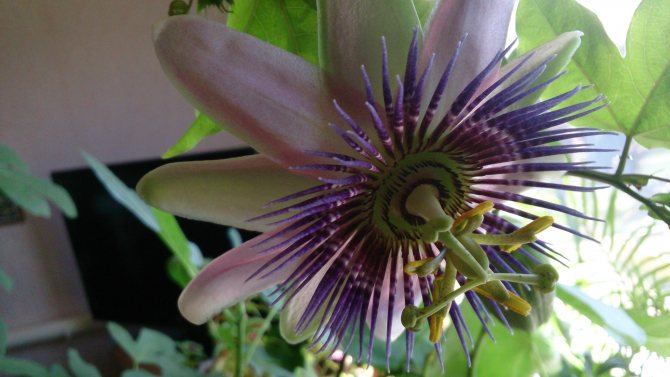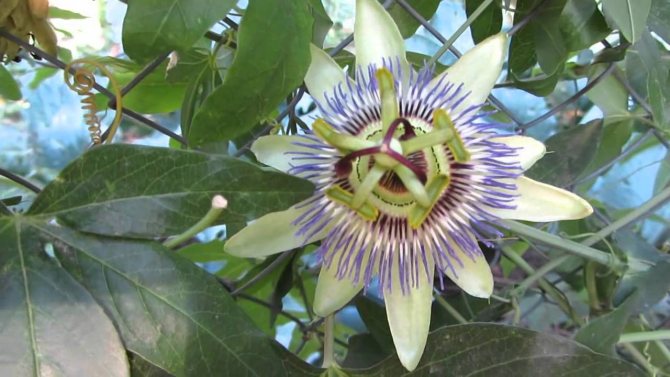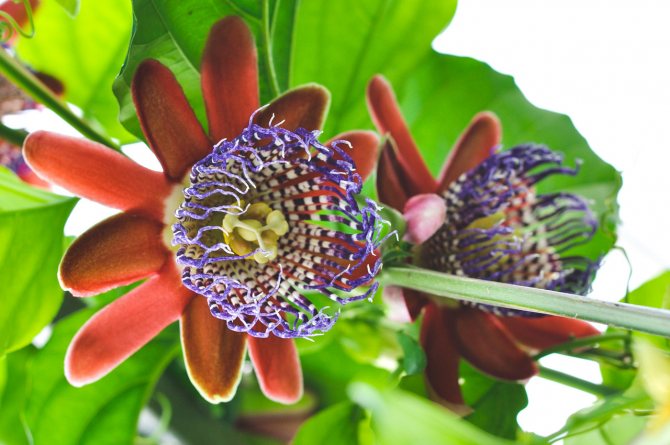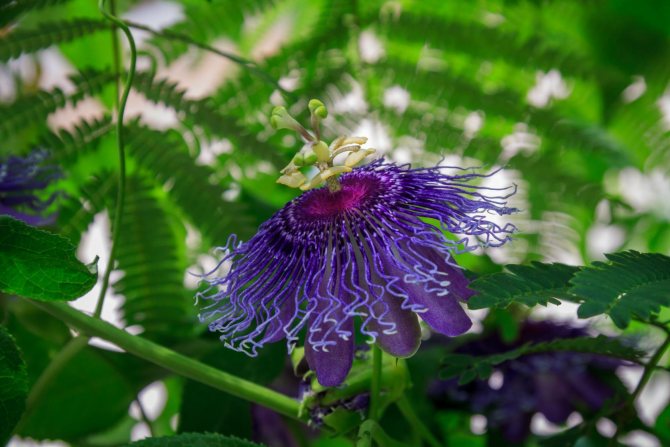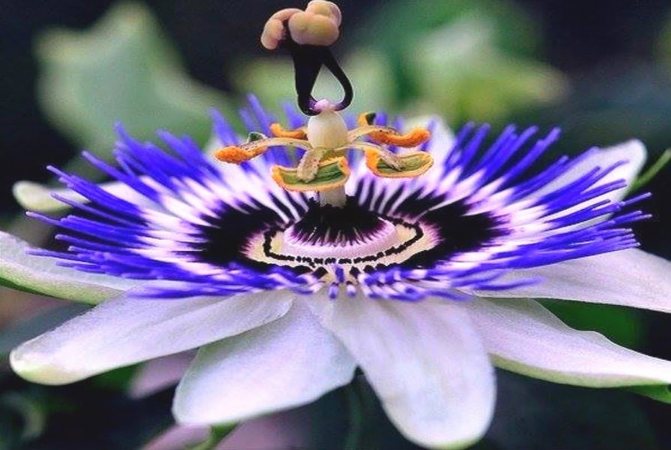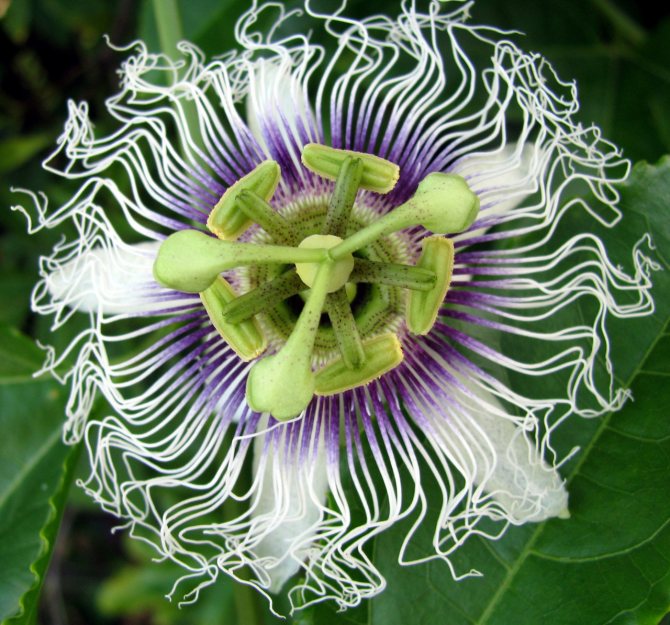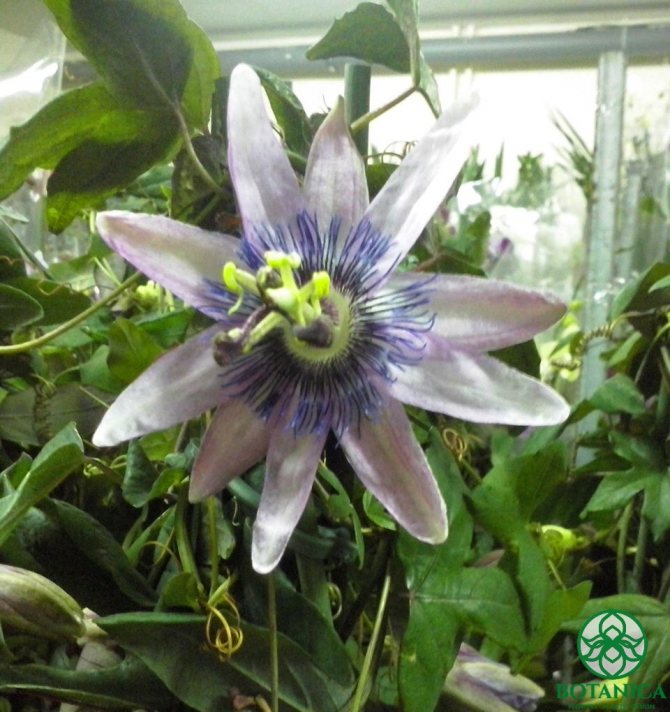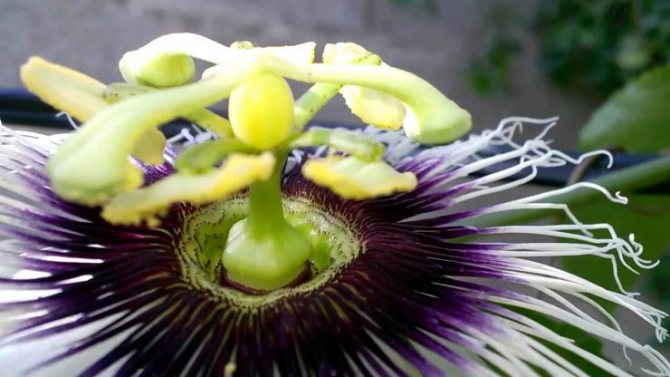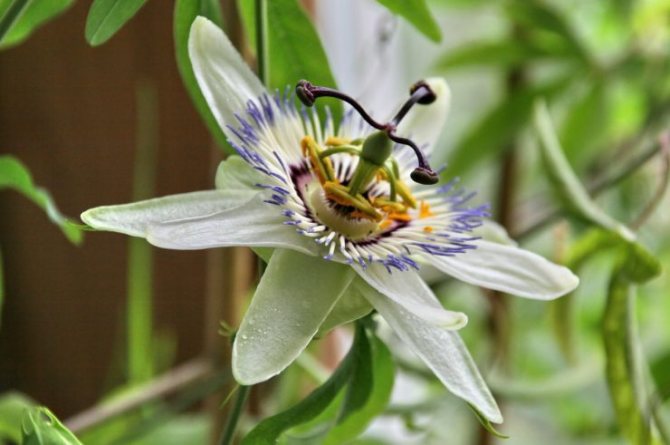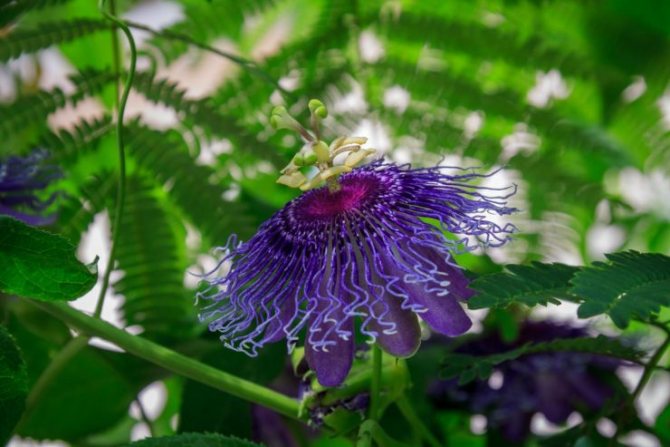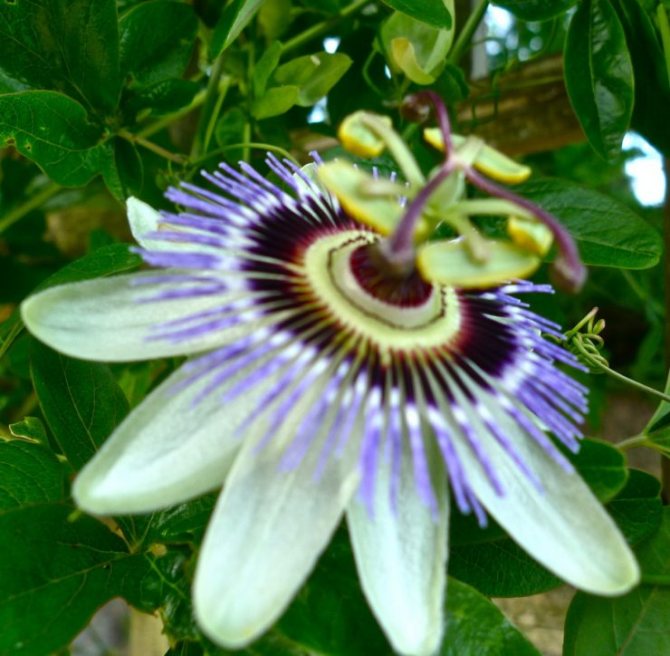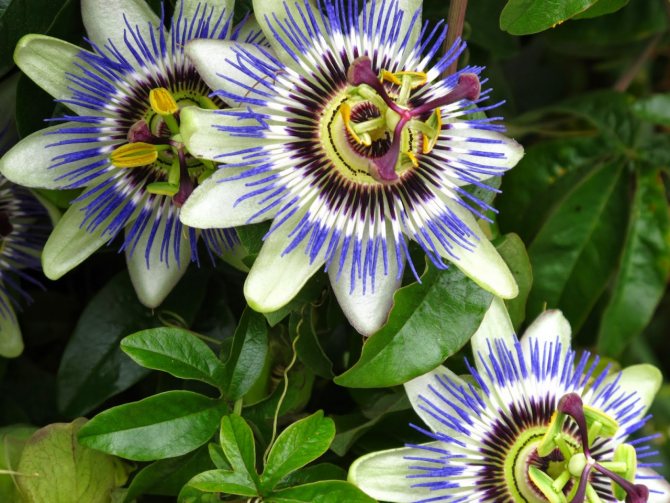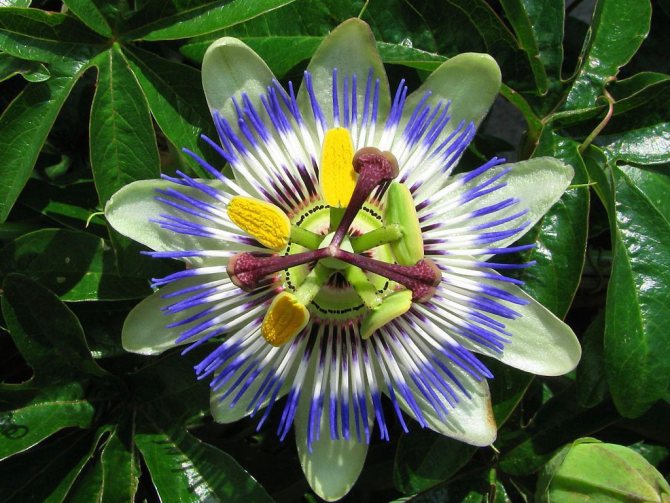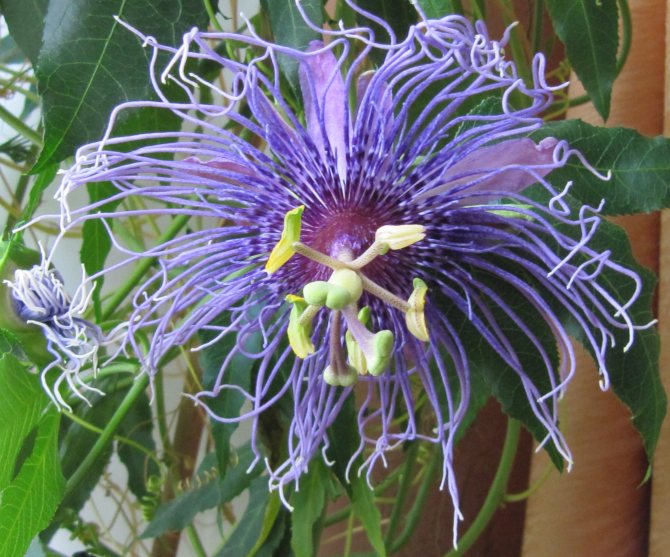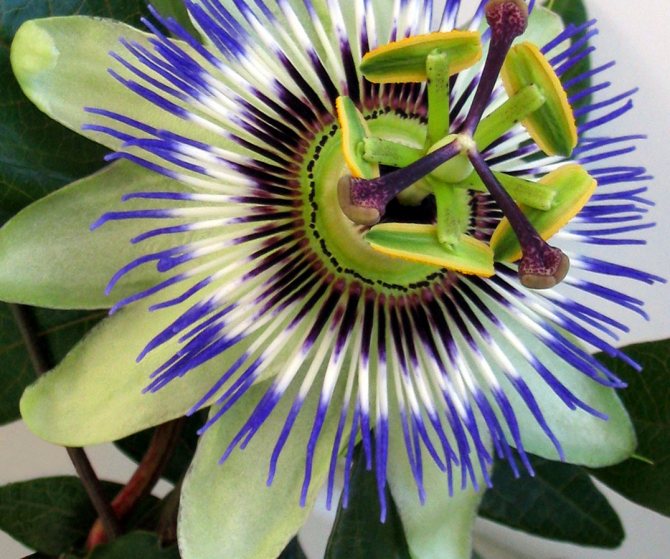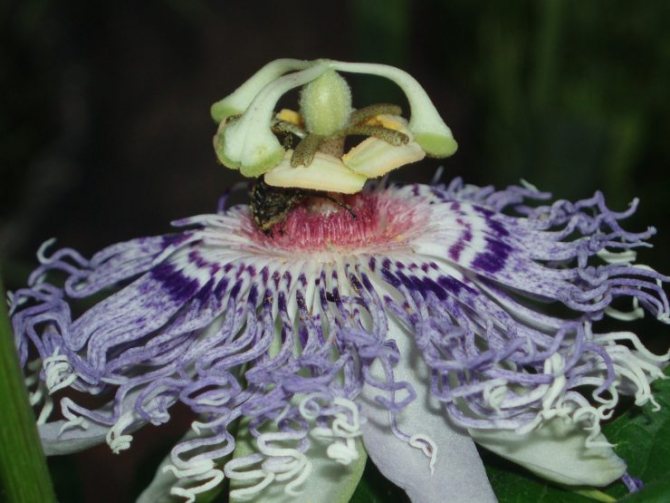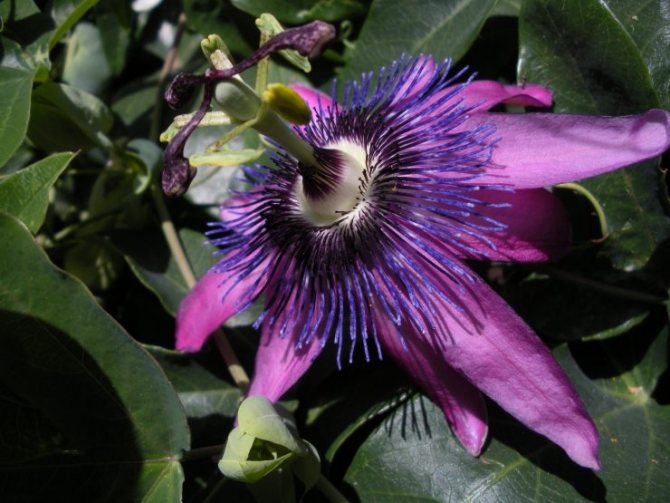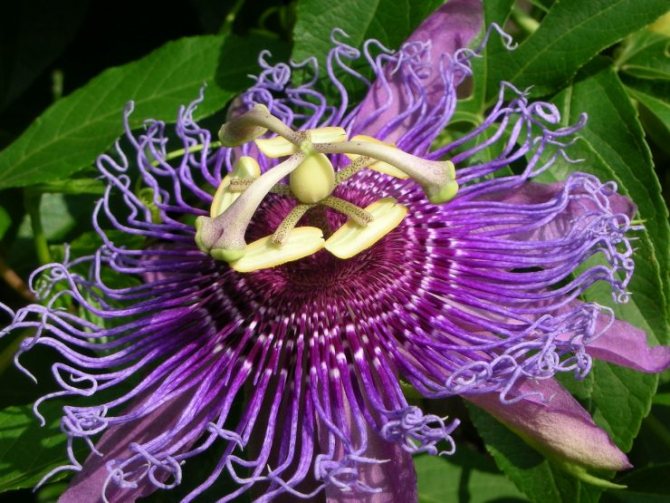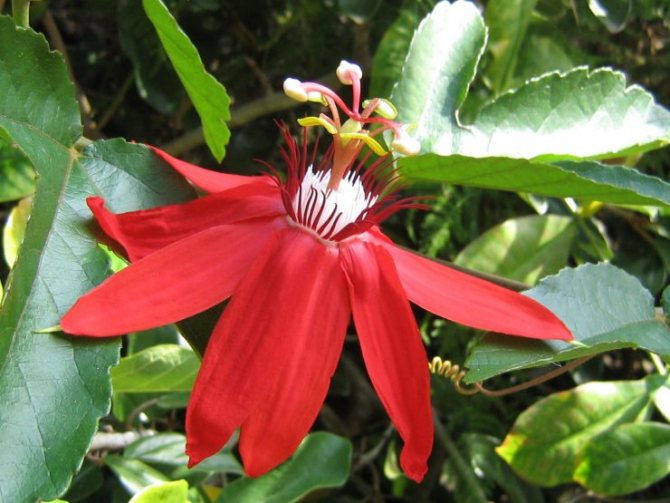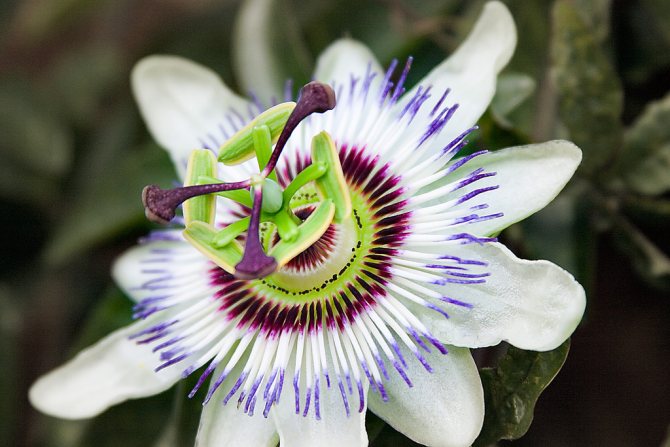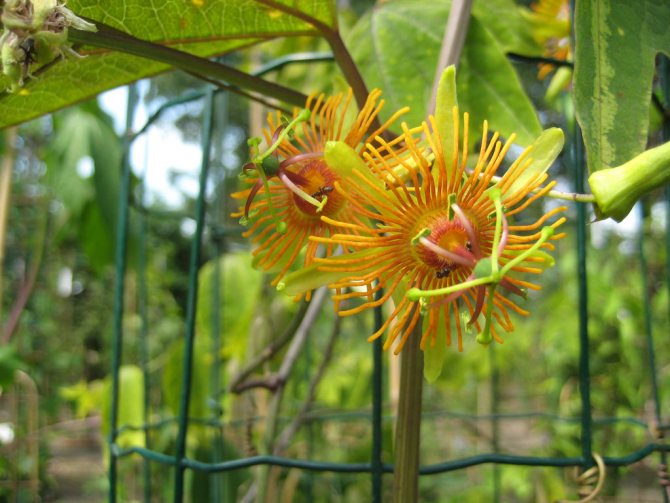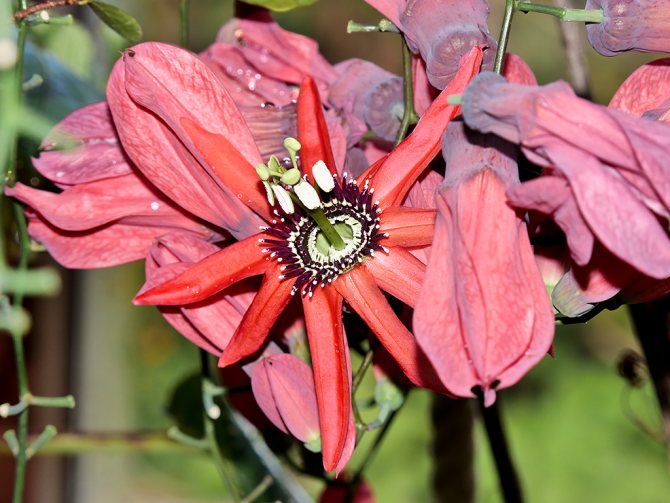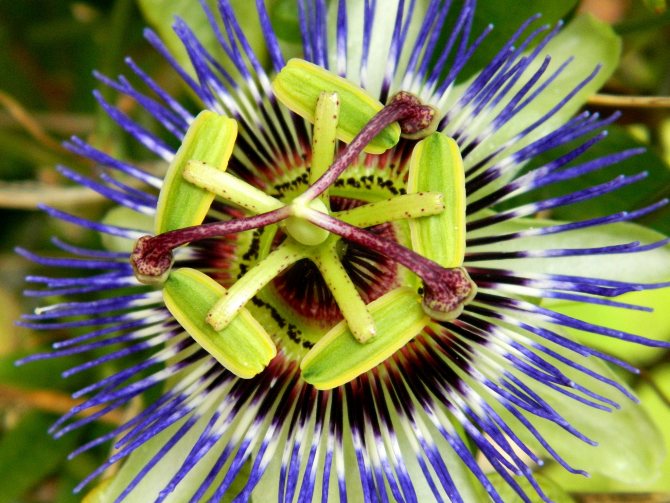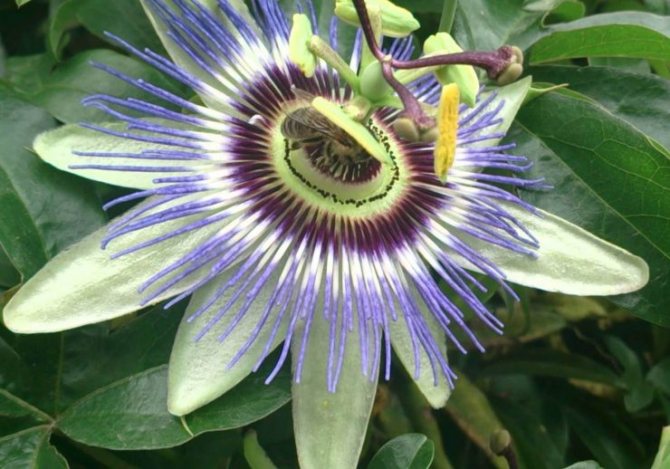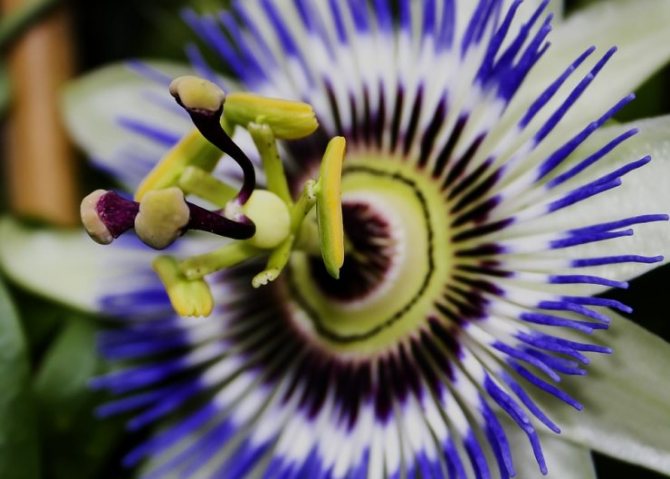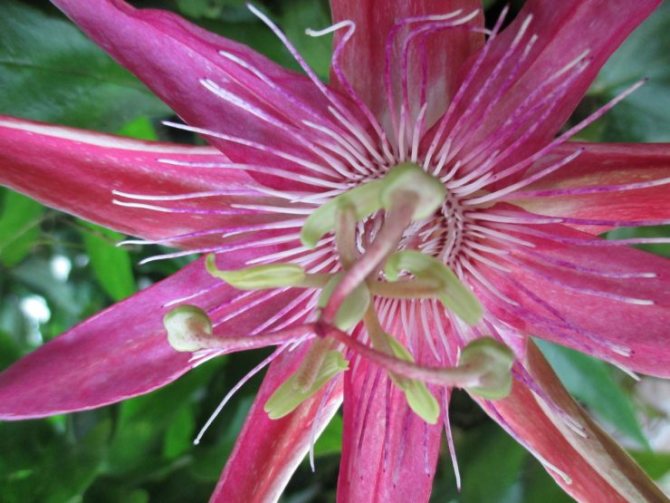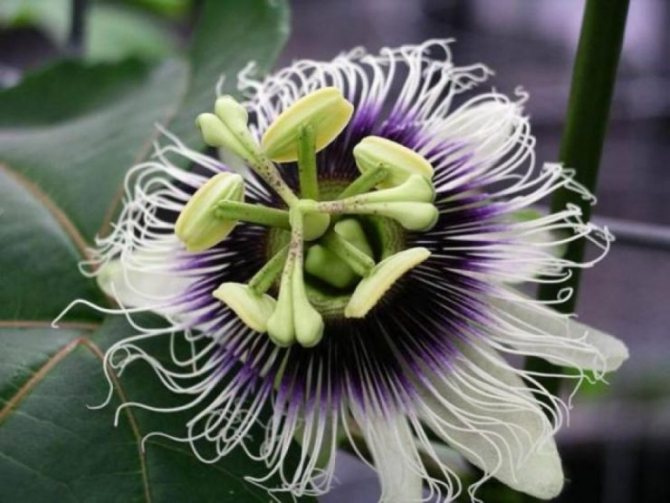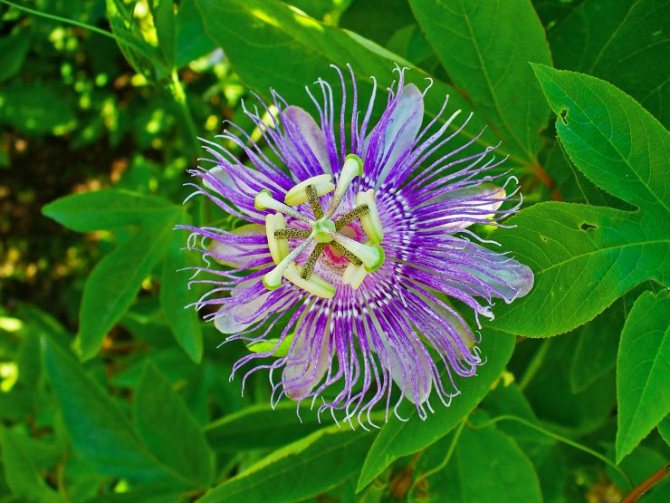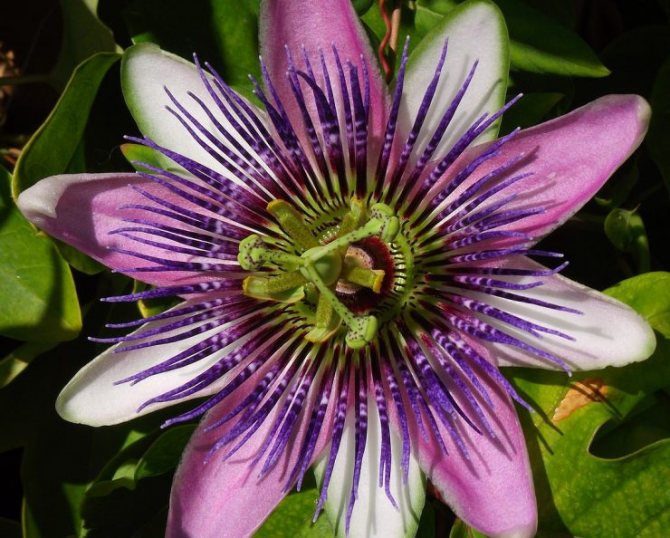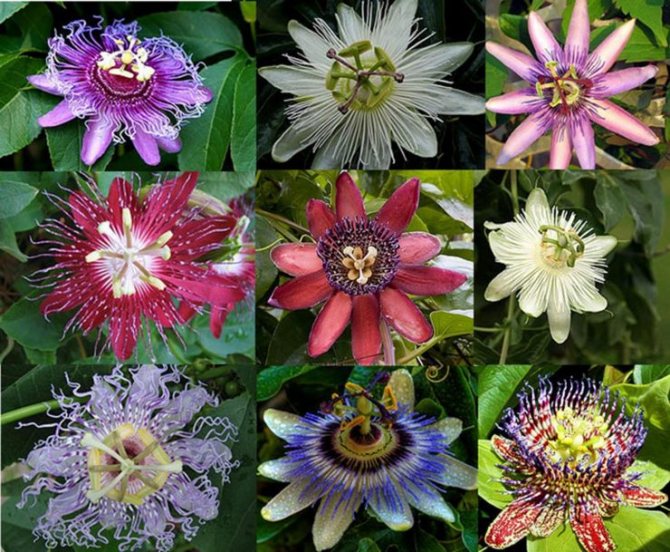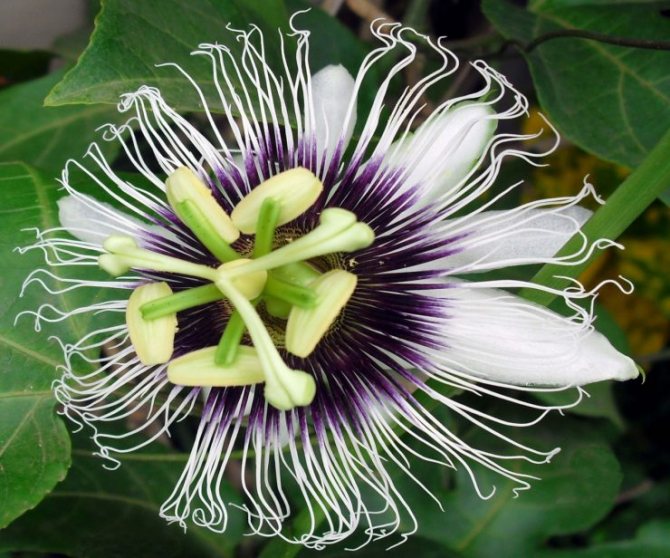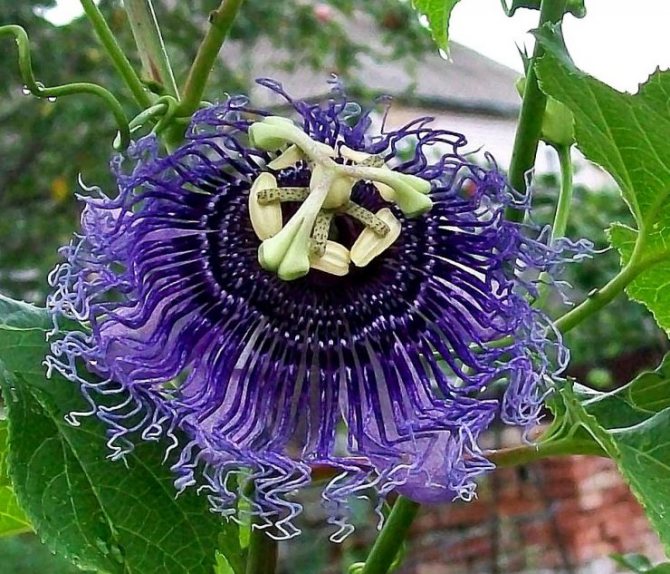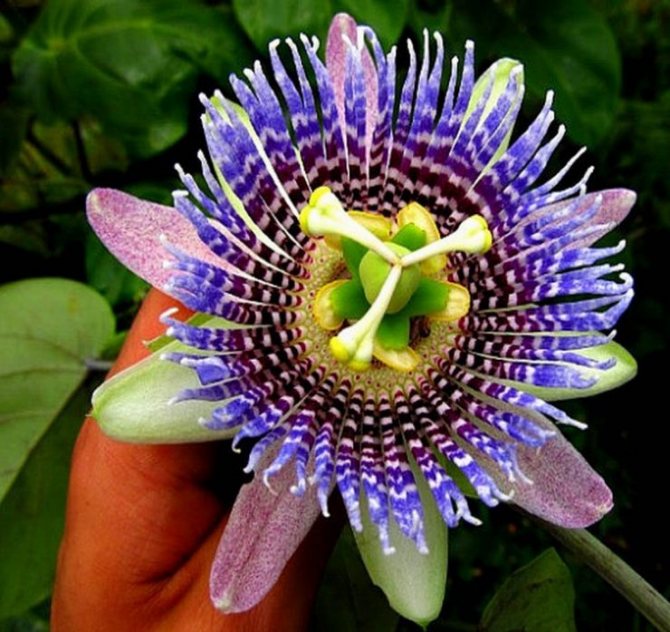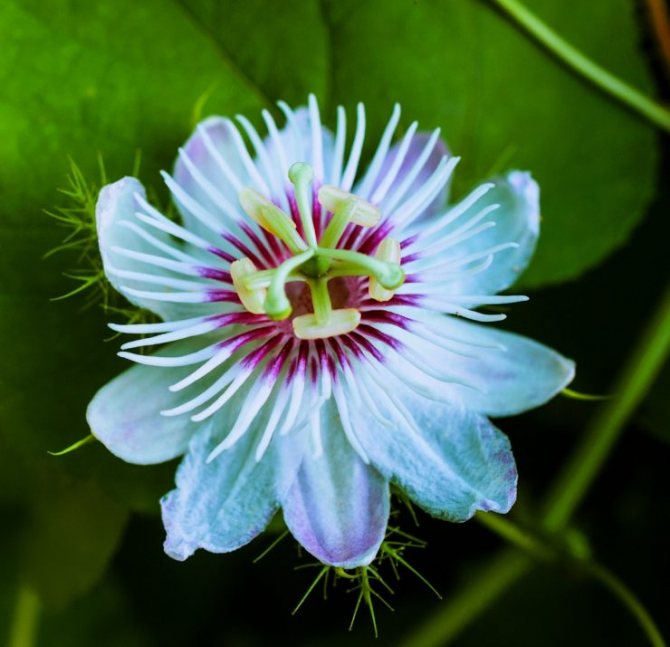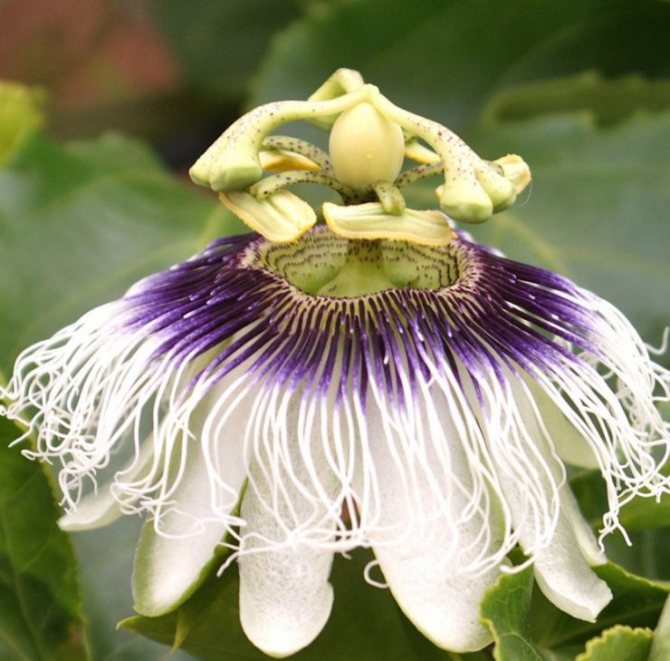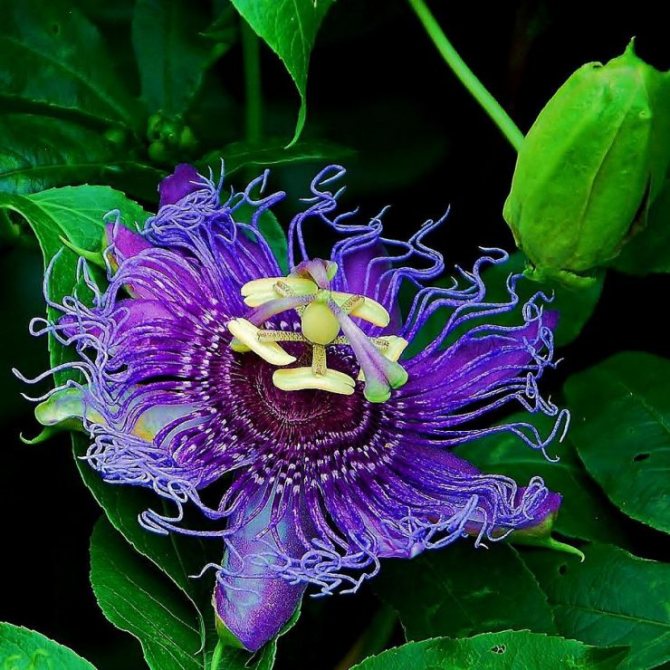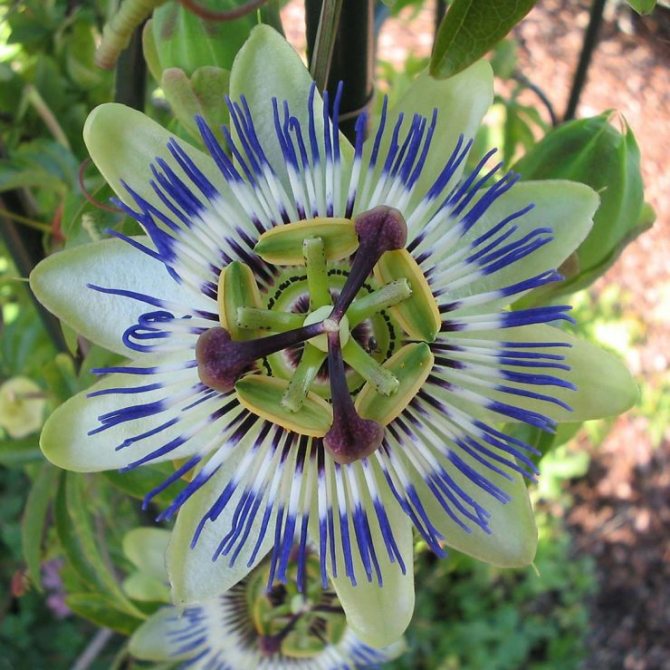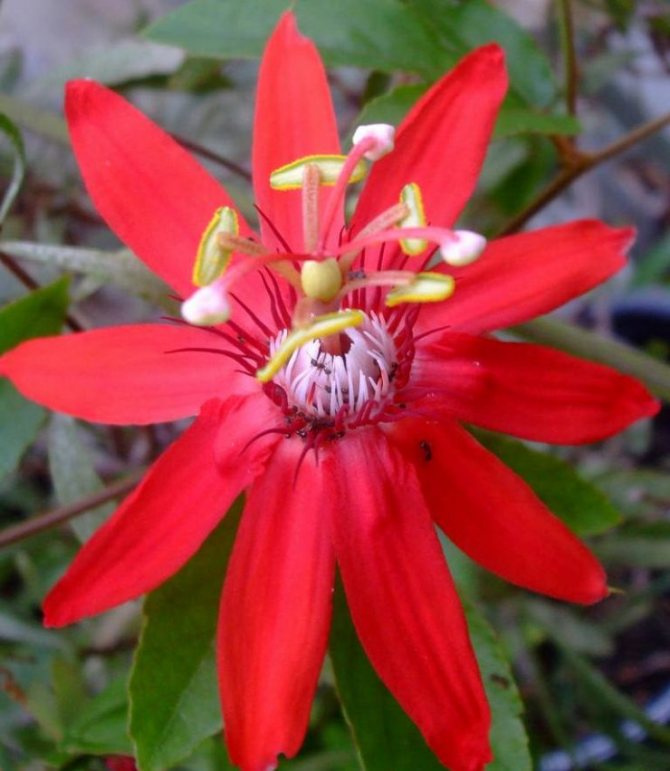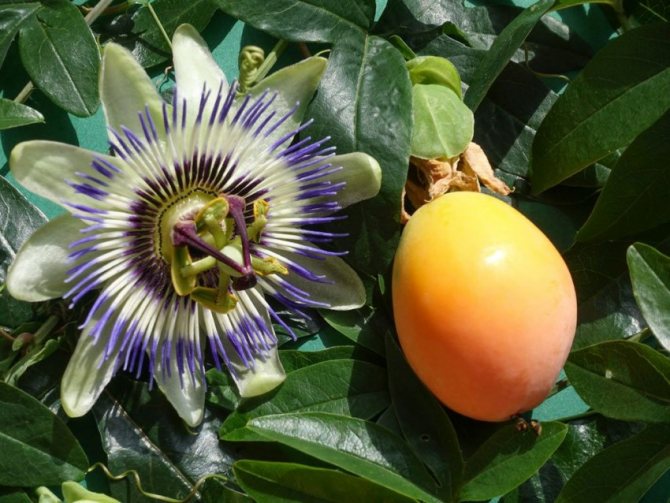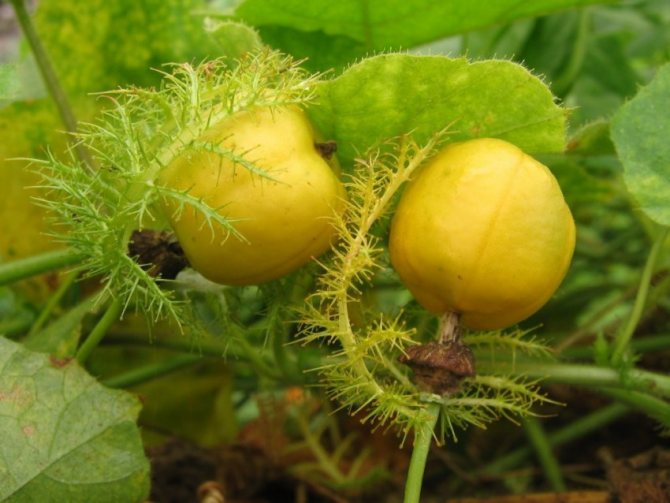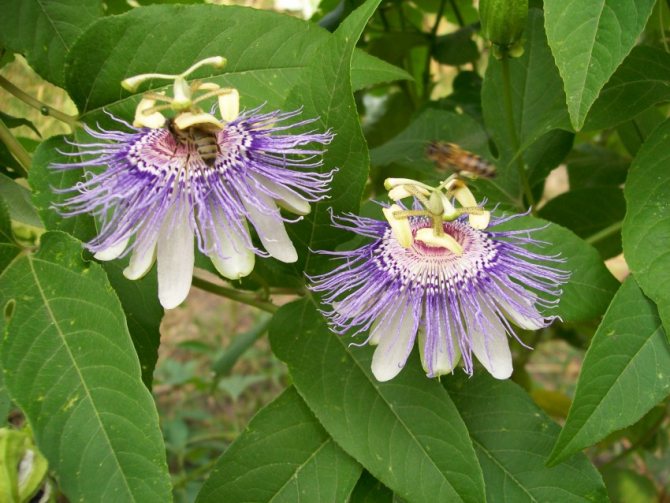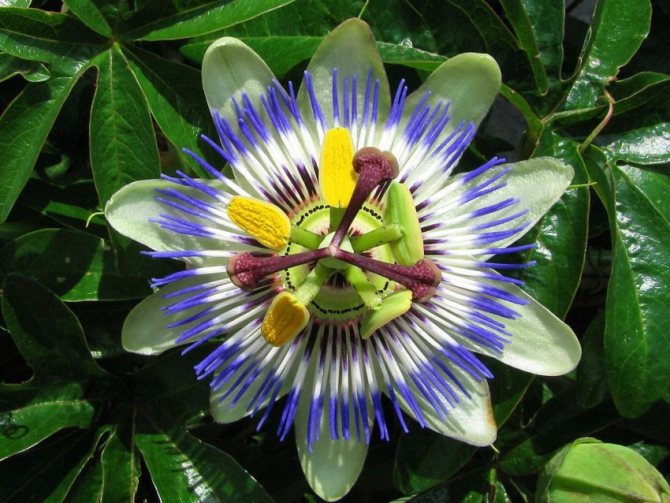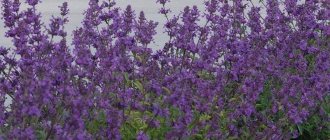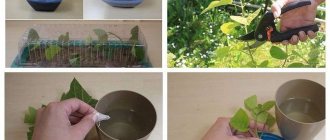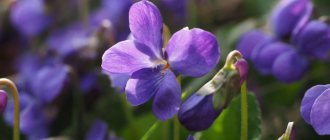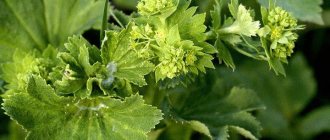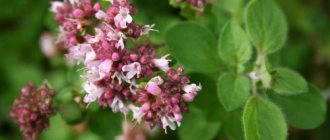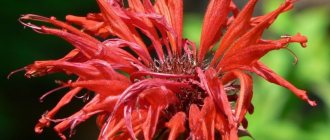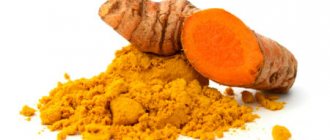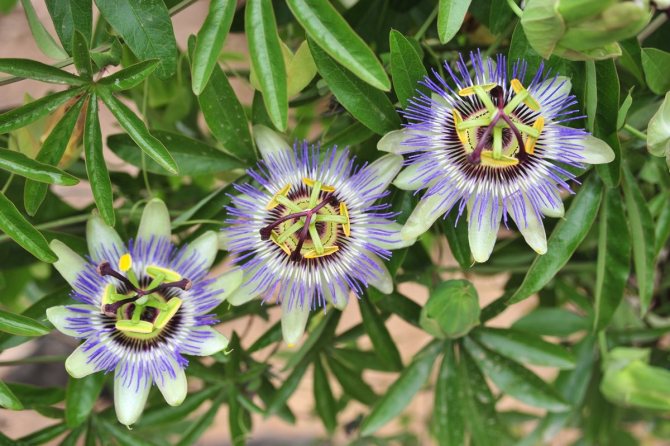
Passionflower is not only unusual flowers that will decorate any garden, but also an exotic treat. Some species give juicy and healthy fruits. She is unpretentious in care, but requires some skills and knowledge from the gardener.
Belongs to the passionflower family. It can be either a liana-like perennial shrub or an annual herb. Its habitat is tropical forests. Grows wild in Australia, Asia, Peru and the Mediterranean. The plant has a developed and strong root system. The main root is up to 2-3 cm thick and up to 2 meters long. Stems are flexible, smooth and thin, they can be 10 m or more in length.
In their natural habitat, the length of some specimens is 45 meters.
The leaves are dark green in color, lobed or solid. The petioles are average about 3 cm, they serve to accommodate the leaves. Long stalks form colorful flowers with a diameter of 50-150 mm, depending on the species. The flower consists of five: sepals, petals, bracts and stamens, as well as three stigmas.
What is passionflower
Passionflower is a tropical liana that moves along the support with the help of tendrils (shoots). It grows in humid and hot climates. It has large leaves and unusual flowers with a strong aroma. Due to the appearance of the flower corolla, the plant is called passion flower. The fruit is edible in some species and is known as passion fruit.
In medicine, all the herbaceous parts of passionflower are used. Extracts, homeopathic remedies, tablets are prepared from it. The sedative, hypnotic, analgesic effect of the plant is used for treatment. od
Diseases and pests of passionflower
In winter and autumn, excess moisture leads to the development of fungal diseases, which appear as spots on the leaves, after which they wither or die off. For the purpose of prevention, such passionflower is treated with fungicides.
If watering is incorrect, root rot may occur. In this case, the entire system is cut and re-rooting is performed. If decay is observed on the trunk, then healthy shoots are cut off and cuttings are made.
Passion flower leaves are attractive to aphids, scale insects and scale insects. The presence of pests is symbolized by the slow growth of flowers, their pale color and abundant foliage shedding. You can get rid of them with soapy water or insecticides.
The healing properties of passionflower
The plant is a liana with an unusual flower. It was called a passion flower (a symbol of the passions of God) by the Italian naturopath Bosio. He reminded him of a crown of thorns, wounds and spears that pierced the body of Jesus Christ. The use of passionflower for the treatment of convulsive syndrome began in 1840, and then it was widely used for insomnia.
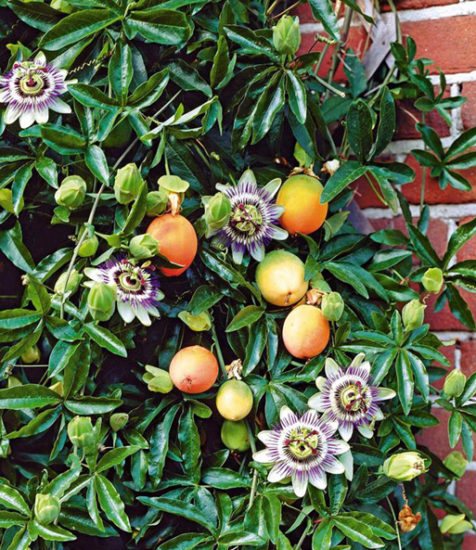

Passionflower (Passionflower)
The therapeutic effect of herbal remedies based on passionflower is based on the following effects:
- relaxes;
- soothes, relieves mental stress;
- in low doses it acts as a tranquilizer, and in high doses it acts as a sleeping pill;
- improves mood;
- does not cause addiction, states of depression after sleep;
- cancellation is not accompanied by a deterioration in well-being;
- relieves stress-related spasms of the esophagus, stomach and intestines;
- helps with abdominal pain on the background of premenstrual syndrome;
- lowers blood pressure in hypertension;
- has an anticonvulsant effect.
We recommend that you read the article on tinctures for the heart. From it you will learn about tinctures for the heart, blood vessels, nerves, as well as cocktails and drinks to strengthen the myocardium. And here is more about herbs for tachycardia.
Photo gallery
The benefits and harms of passionflower
The benefits and harms of passionflower were established in the course of studying the effectiveness of the plant, during which it was found that when taken in patients:
- sleep improved;
- decreased irritability, nervousness, less often there was anxiety;
- increased general tone after the flu.
The use of passionflower extract proved to be effective in traumatic brain injuries, neurasthenia and irritable weakness syndrome. Taking medications made it easier to concentrate, eased headaches. In the climacteric period, hot flashes and sweating, pressure drops began to bother less often, the heart rhythm returned to normal. Adverse effects were expressed in skin itching, rashes.
Pruning when caring for passionflower: how to prune a flower during cultivation
After the first year of active growth, the passion flower begins to be cut. This procedure is carried out every spring: it stimulates the development of plant shoots and their beautiful branching.
Pruning homemade passionflower provides for the removal of dry or rotten branches, pinching the shoots. Flower buds form only on young shoots, so last year's should be cut off by a third. Branches that grow at the base of the stem are also removed. The cut sites should be treated with a solution of potassium permanganate, which will prevent rotting or the development of infection.
If you follow the advice and cut the passion flower in the way recommended by experienced flower growers, it will delight you with a thick crown and abundant flowering. The main thing is not to overdo it with the removal of strong and healthy shoots, because after that the plant can get sick.
Passion flower: beneficial properties
The beneficial properties of passionflower include:
- soothing for neurosis, irritability, the effects of stress, flu, trauma;
- improvement in depression, menopause;
- improved sleep with insomnia;
- anticonvulsant;
- getting rid of addiction (alcoholic, drug) in combination with psychotherapy;
- stabilization of pressure in neurocirculatory dystonia;
- pain relief for functional (without serious diseases) pain in the heart, abdomen, headache.
Passion flower normalizes blood pressure in neurocirculatory dystonia
Favorable conditions
The tropical passionflower loves warmth. The optimal temperature regime is +25 degrees in summer and +15 in winter. The main thing is to avoid strong temperature changes. Unfavorable growing conditions adversely affect the leaves with buds.
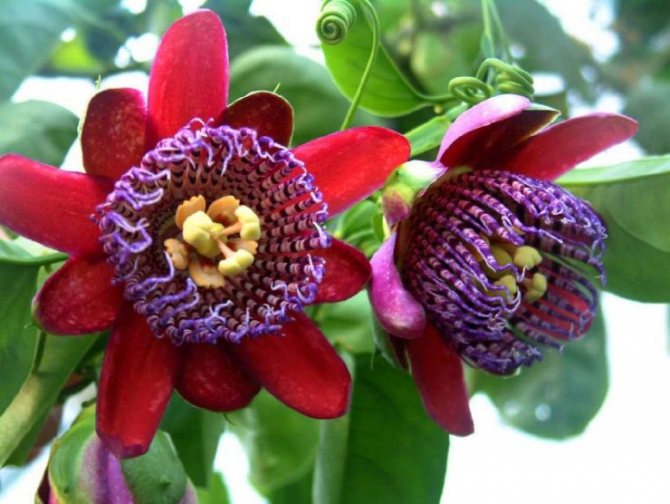

With the onset of warm days, the plant is taken out of the room, it needs sunlight. If you can't move it to the garden, place the pot on the southern windowsill. Passionflower is a flower that does not like shade.
When used in medicine
The use of passionflower extracts is recommended for the following symptoms:
- increased excitability;
- unstable mood;
- a state of anxiety, internal anxiety, fears, gloomy forebodings;
- tendency to violent reactions of anger, aggression, impatience;
- low mood, anxiety, a sense of hopelessness, loss of appetite;
- violation of falling asleep, frequent awakenings;
- frequent headaches after emotional stress;
- increased heart rate, accelerated pulse;
- hot flashes followed by chills;
- sweating, cold and damp palms;
- numbness, tingling in the limbs;
- difficulty swallowing, "lump in the throat";
- feeling short of breath;
- muscle twitching, hand tremors, muscle spasms;
- abdominal pain, diarrhea;
- increased urine flow.
A characteristic sign of the connection of these symptoms with a neurotic state is their occurrence and intensification after conflicts, stress, experiences. Rest and relaxation lead to their disappearance or significantly improve the well-being of patients. It is also important that instrumental and laboratory diagnostics do not reveal any abnormalities that could be associated with similar clinical manifestations.


Stress, anxiety - indications for taking passionflower
Anxiety disorders are not so harmless, against their background, the risk of angina pectoris and myocardial infarction, hypertension, and cerebrovascular accidents increases. Therefore, the use of passionflower in these conditions is important in the prevention of cardiovascular pathology.
Application of flowers and leaves of passionflower
To get rid of neurocirculatory dystonia, with nervousness and fears, flowers and leaves of passionflower are used independently. The effectiveness of the therapy is increased when combined with other herbs with a calming and relaxing effect. The following collection is recommended:
- passionflower herb 30 g,
- hawthorn flowers 40 g,
- valerian root 10 g,
- anise fruits 10 g,
- lemon balm leaf - 10 g.
To prepare the broth, a teaspoon of the mixture is poured with 100 ml of boiling water and kept in a water bath for 10 minutes. Drink a drink 30 minutes before dinner and before bedtime, 50 ml. The course of treatment is 1.5 months.
Phytocompositions with passionflower are effective for vascular diseases of the brain. For patients who have undergone a hypertensive crisis or a temporary violation of cerebral circulation (in addition to medications), a composition of equal parts of skullcap, astragalus and passionflower is recommended.
Hypertensive crisis - an indication for taking passionflower
These herbs need to be finely chopped and brewed in a thermos overnight. Proportion: 200 ml of boiling water is required for a tablespoon of the collection. Take a third of a warm infusion with 0.5 teaspoon of honey before meals. The duration of therapy is at least 1 month. After a 2-week break, the reception is repeated.
Passion flower and its fruits
Passionflower fruits are used in cooking. They are eaten fresh and added to yoghurts, ice cream, desserts, along with other fruits. When added regularly to the diet, passion fruit helps:
- strengthen immunity;
- prevent cancer;
- improve visual acuity;
- moisturize the skin (masks are prepared and consumed);
- cleanse the intestines;
- normalize blood sugar and cholesterol levels;
- dilate blood vessels and lower high blood pressure;
- stimulate blood flow to the heart muscle, which is important for ischemic disease, angina pectoris;
- increase bone mineral density (prevention of osteoporosis and fractures in the elderly, with menopause);
- make it easier to fall asleep.
To do this, it is enough to eat 2-3 fruits a day.
Passion flower edible
The fruit of the edible passionflower is the passionfruit. They have a pleasant sweet taste with a slight sourness. They contain organic acids, provitamin A, ascorbic acid and group B. Passion fruit is rich in antioxidants that protect tissues from destruction by free radicals, capillary-strengthening compounds.
The mineral composition is represented by potassium, iron, calcium and copper. The fruits also contain selenium and zinc. Caloric content - 97 kcal per 100 g.
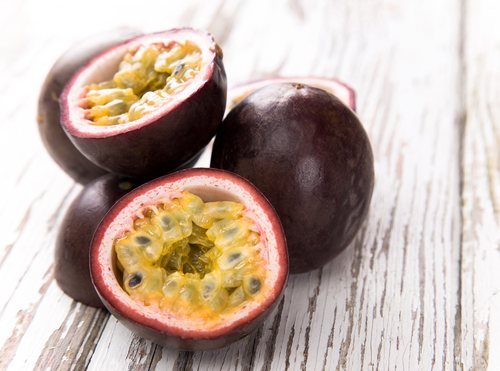

Passion fruit
Passion fruit oil: properties
Passionflower oil (passionfruit) has properties to nourish, soften and moisturize the skin, makes it silky and reduces wrinkles. It strengthens hair, relieves itching, provides shine and a healthy look. Additives to massage mixtures help enhance the soothing and relaxing effect of the procedure, relieve muscle pain and swelling.
To enrich the cream, it is mixed with oil in equal proportions, but it is also possible to apply a pure passionflower oil extract to the skin.
Breeding features
Passionflower blue and other species are propagated vegetatively or with the help of seeds. The first method is used most often, since in this case the fruits can be obtained in the first year. Mainly cuttings are carried out. If the described flower forms rhizomes, parts of them can be used.
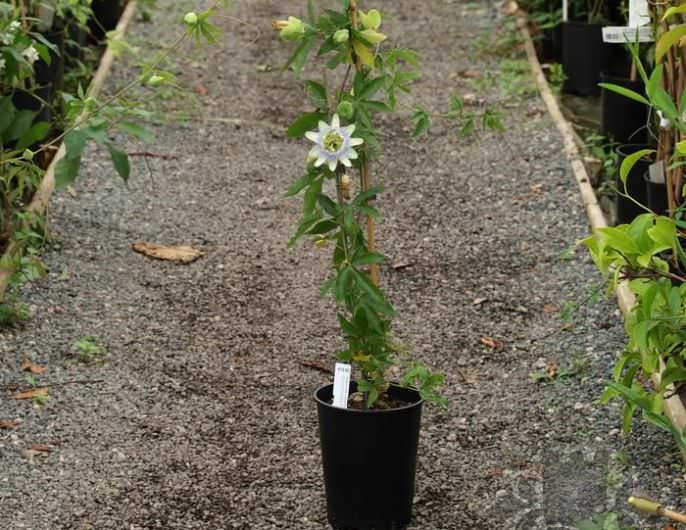

Cuttings represent mature shoots. Slice them with 2 leaves. The lower one is removed, a part of the internode is left under the kidney. If the top sheet is large, you can trim it.
The handle is dipped into Kornevin. This makes rooting much faster. Rooting takes place in a mixture of sand, peat and perlite. Then blue passionflower is covered with a frame with a film. Growing in a greenhouse will be faster if heated from below. Passionflower (see photo) grows somewhat slower in comparison with other species.
In a greenhouse, roots on cuttings appear only after 2 months. After rooting, the film is removed and the hardening of the plants begins. This will take 10 days. Flowering takes 2-5 years. You can make a practical greenhouse for flowers with your own hands, guided by our advice.
Mustache reproduction can be carried out. In winter, seed propagation takes place. They are placed in a substrate consisting of sand, leaf and humus soil, peat. Then they are covered with glass and grown in closed conditions at a temperature of 22-24 degrees. After the first 2 leaves appear, a dive occurs.
Passion fruit: useful properties and contraindications
The beneficial properties of passion fruit are associated with a positive effect on immunity and metabolism, and contraindications - with the ability to cause allergic reactions. Therefore, it is used in nutrition:
- after 6 years of age;
- in the absence of food allergies;
- after testing for individual tolerance.
Therefore, the first time you can eat no more than 1 fruit, and when itching of the skin and rashes, passion fruit is not recommended. With a good reaction, the introduction to the menu is shown when:
- vitamin deficiency;
- frequent colds;
- fluctuations in blood pressure;
- constipation;
- climacteric syndrome;
- pain in the heart, rhythm disturbance;
- osteoporosis.
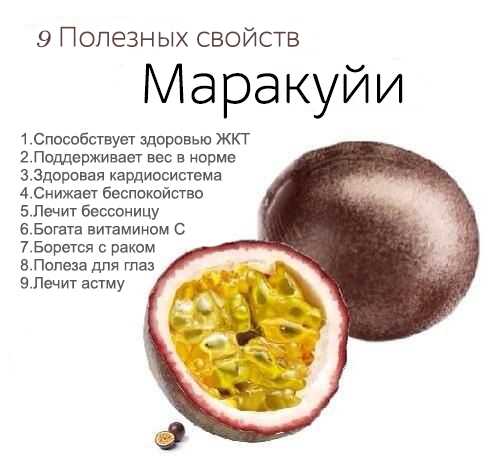

At the same time, it is important to understand that passion fruit does not have a therapeutic effect, it is just a prophylactic agent. In the presence of diseases, its use improves the general condition of patients.
Passionflower or passion fruit
08/28/2018 Plants of the genus Passionflower
(lat.
Passíflōra
) are tropical evergreen lianas, well known for their decorativeness, some of which can reach lengths of up to 45 m. Passiflora is home to a tropical rainforest region with a humid and hot climate located in South America. It covers the southern regions of Brazil, the territory of Paraguay and the northern part of Argentina. The high decorative qualities of passionflower (openwork leaves, original structure and color of flowers), its rapid growth, long flowering period and unpretentiousness contributed to the wide spread of the culture in horticulture, as well as its use in vertical gardening, for decorating gazebos, pergolas, creating shady zones, etc. . P.
Among the numerous representatives of passionflower, there are plants with both whole and palmate (three-, five-, nine-lobed) leaves. Passiflora flowers are single, large (on average about 10 cm in diameter), with a bright and elegant double perianth, above which are placed in the form of a fringe straight or wavy filaments of multicolored colors, forming a kind of "crown". In the center of the flower there are five stamens, above them there are three cross-shaped stigmas of the pistil. The ministers of the Christian religion used the unique structure of passionflower flowers to symbolize them as the personification of the sufferings (passions) of the Lord, which gave rise to the name of the plant.Translated into Russian, passionflower means passionflower.
Of the more than 500 species of passionflower, only a few (incl. passion fruit
,
passionflowermeat-red
,
chulyupa
,
passionflower reed
and others) form edible berries, which are a valuable food and dietary product. In addition, the fruits of passionflower, as well as its aboveground part, have medicinal properties and are successfully used not only in folk but also in official medicine. Flavonoids, carotenoids, alkaloids, coumarins, glycosides, saponins, quinones, vitamins and trace elements, as well as many other useful components, are found in the stems and leaves of the plant.
Shoots, buds and flowers are harvested during the flowering period of passionflower, then dried in a shaded, well-ventilated room or at a temperature of + 50 ... 60 ° C. Tea, infusions and extracts from dried herbs are used as antispasmodic, antibacterial, antifungal agents. Passionflower is a part of pharmaceutical preparations that have a sedative effect. It is also used as a biologically active ingredient that helps to get rid of alcohol and drug addiction.
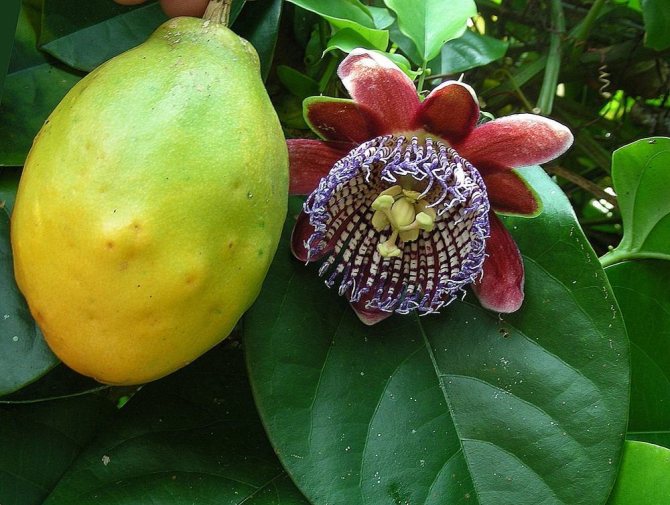

Today, fruit species of passionflower are cultivated as perennial climbing fruit bearing plants not only in Brazil, but also in the Mediterranean countries, subtropical zones of Asia, in New Zealand, Australia, and on the Polynesian islands. One of the most common and well-known among them is passionflower edible
(lat.
Passiflora edulis
, family Passionaceae), also known as
passion fruit
,
granadilla
or
passionflower edible
... It is an evergreen herbaceous vine up to 10 m long, forming unusually beautiful, bright flowers. After pollination (with the participation of hummingbirds in their natural habitat or artificially when grown in other regions), rather large (8 - 15 cm) fruits are formed.
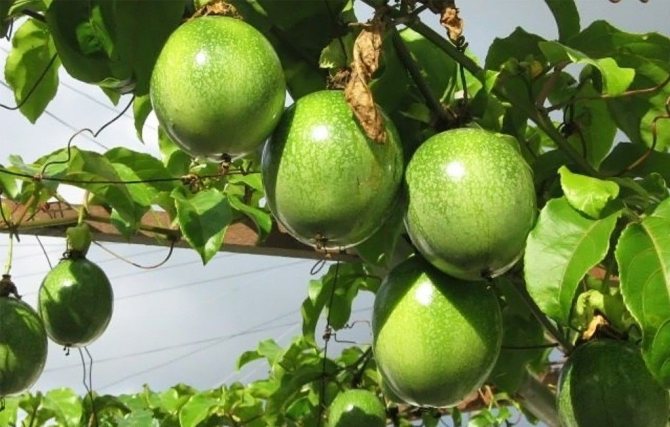

The edible passionflower fruit, well known to us as passionfruit, has a spherical shape, top covered with a dense glossy skin of yellow, orange or purple color, under which there is a juicy, aromatic, sweet and sour pulp, filled with dense and also edible seeds (up to 30 pcs. And more). It contains fiber, protein, carbohydrates, saturated and unsaturated fatty acids, pectin compounds, chlorophyll, many vitamins (A, group B, C, PP, E, K, etc.), antioxidants, macro- and microelements (potassium, calcium, sodium, magnesium, iron, copper, zinc, phosphorus, sulfur, fluorine, etc.). The calorie content of 100 g of fruit is 68 kcal. The fruits are eaten fresh, choosing the pulp from the berries cut in half. Passion fruit is often used as a flavoring and filler in fermented milk and tonic drinks, in desserts, ice cream. Jams, jellies, juice, syrup are prepared from it, added to hot sauces and marinades.
Regular moderate consumption of passion fruit is beneficial for health. This product improves the functioning of the digestive tract, helps to restore the functions of the genitourinary system, regulates the hormonal sphere (especially during menopause and during menopause), strengthens blood vessels, improves immunity, relieves depression and other disorders in the central nervous system, headaches (leaves and seeds ), is an effective tool for the prevention of cancer. Passion fruit also has a rejuvenating effect, improving the condition of hair and skin. This property of the fruit is used in cosmetology: passion fruit oil is included in many anti-aging creams, masks, regenerating shampoos, gels, etc.
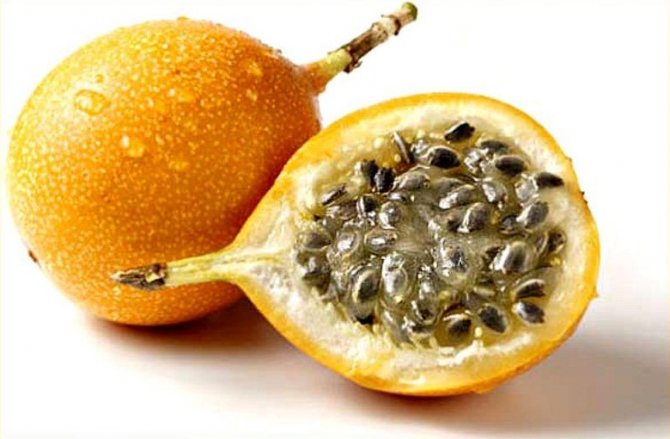

At the same time, it is necessary to remember about contraindications. Passion fruit is not recommended for people who are prone to allergic reactions, with urolithiasis or cholelithiasis, stomach or duodenal ulcers, as well as in the case of cardiovascular diseases (myocardial infarction, angina pectoris, atherosclerosis, hypotension). Care must be taken when including this fruit in the diet of pregnant women, nursing mothers and children under 3 years of age. In addition, passion fruit (mainly fruit seeds) can cause drowsiness and decreased attention, which is dangerous for those whose profession requires quick reaction and increased observation.


Although passionflower is a thermophilic plant, it is grown as an annual in regions with more severe climatic conditions. It can also successfully grow and develop in closed ground (greenhouses, greenhouses, winter gardens, etc.) or in the form of a room pot culture, as an ampelous plant. Passionflower propagates with the help of seeds (a more laborious method), which are placed in a container with soil at the end of February - early March or vegetatively (by cuttings).
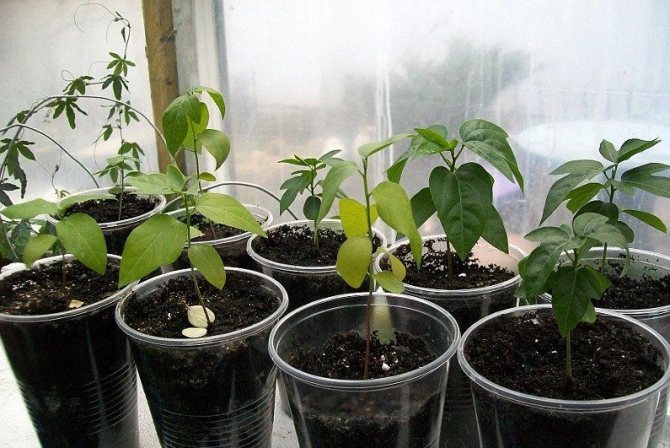

To grow passionflower at home, you need to pick up a small but high enough container (flower pot) for the plant, fill it with a drainage layer (expanded clay, crushed stone, brick chips) with a height of at least 2.5 cm and a loose, breathable soil mixture (leaf humus , compost, sand, turf soil) with a neutral or slightly alkaline pH reaction. The seeds are pre-scarified with a little sandpaper, treated with a growth stimulant and planted in a container (flower pot) with moist soil mixture, which is then covered with a film. The optimum temperature for the emergence of seedlings is + 20 ... 25 ° С with a humidity of 75%. Seedlings can appear within 30 days or more, after which the film is removed.
Passionflower is a light-loving plant, but it can grow in partial shade. Like all vines, she needs support. If you grow passionflower in suspended pots, as an ampelous culture, then it is necessary to prune the plant in time. Cut shoots (at least 20 cm long, with two internodes) are also planting material: they can be easily rooted by first placing them in a jar of water and a small piece of charcoal, and with the appearance of roots in the prepared soil. When placing a container with a plant indoors or outdoors, remember that passionflower does not tolerate drafts.
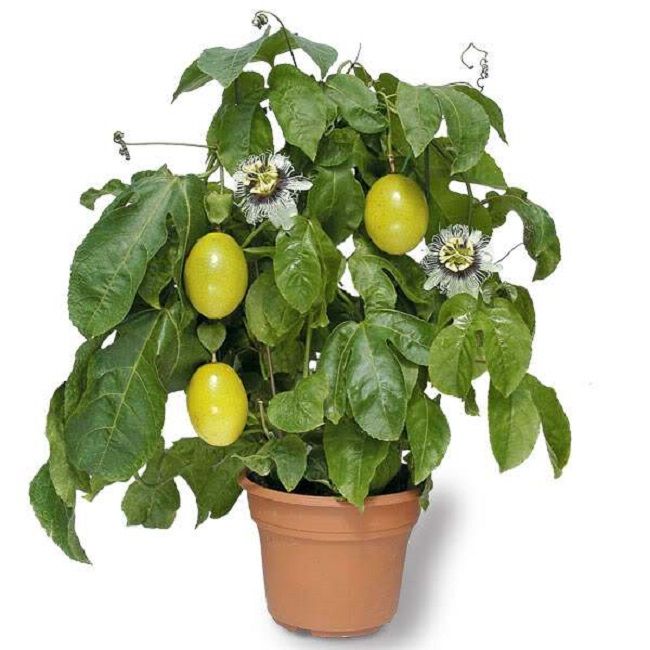

Passionflower needs constant moistening of the air and soil (while avoiding waterlogging or stagnation of water in it), especially in the summer. Spraying is carried out in such a way that the plant at this time is not in direct sunlight. In winter, during the dormant period (December - January), watering is almost stopped, making sure that the soil does not dry out, and the ambient temperature at this time should be within + 12 ... 18 ° С. A sufficient amount of moisture is beneficial for the development of culture. An excess of nutrients in the soil provokes the abundant formation of the vegetative mass of the plant to the detriment of the quantity and quality of the fruits, therefore, mineral fertilizers should be applied sparingly.
It must be borne in mind that the plant is extremely sensitive to temperature conditions. Passionflower does not like cold, as well as excessive heat: at air temperatures below + 12 ° C and above + 30 ° C, it stops growing. Flowers are formed on the shoots of the current year. Interestingly, in natural conditions, passionflower copes with pests (caterpillars of heliconium butterflies) on its own. On its aboveground organs (leaves, petioles) glands are located that secrete a specific substance that attracts ants, which destroy dangerous caterpillars.
Indications and method of application of capsules, tablets
Passionflower is most commonly used as a sedative that inhibits the activity of the central nervous system. It can also be used to prevent undesirable effects of stress hormones on the body in such conditions:
- thyrotoxicosis;
- excess adrenal function;
- withdrawal syndrome against the background of abstinence from smoking, alcohol, sleeping pills and tranquilizers of a chemical nature;
- side effects of drugs for bronchial asthma, vasoconstrictor drops from the common cold, cold remedies, corticosteroid and thyroid-stimulating hormones;
- overdose of caffeine, adaptogens (eleutherococcus, ginseng), energy drinks.
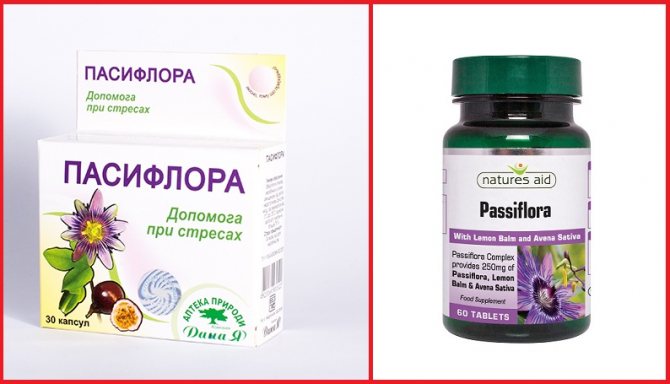

Passion flower preparations are recommended for vegetative-vascular dystonia, neurasthenia, depression, insomnia, pathological menopause, weakness after infections. For adult patients, Alora tablets containing 100 mg of passionflower extract are used as a sedative. They are usually prescribed one tablet 3 to 4 times a day.
In severe condition, the dose is increased to 6 pieces per day. To help you fall asleep and sleep better, take one or two tablets an hour before your night's rest.
For children, tablets can be used for treatment only after 12 years. For a younger age, syrup is recommended - after 3 years it is drunk with a coffee spoon 2 - 3 times a day. The duration of therapy is set individually, depending on the indications and the patient's condition. A single dose must not be exceeded.
If, against the background of the use of passionflower, there is a feeling of depression or increased fatigue, then the morning and afternoon dose is reduced to half the tablet, and the evening dose is left unchanged. The intervals between doses should not be less than 4 hours.
Why Passiflora leaves turn yellow: the main pests and diseases
Under natural conditions, the main pests of most species of passionflower are heliconium caterpillars. But in temperate continental climatic conditions, the plant suffers from other pests and diseases: mealybugs, spider mites and thrips cause the death of passion flower.
Correct care - it is not always a guarantee that an uninvited guest will not appear on the plant.
Mealybug can settle on young shoots, in leaf axils or in buds. The pest feeds on passion flower juice and provokes the appearance of mold. Its reproduction is facilitated by a large amount of nitrogen-based fertilizers and a favorable ambient temperature of about + 26˚С.
Means with cypermethrin, including "Arrivo", "Intavir", will help to destroy the mealybug.
The spider mite also needs the cell sap of passionflower for its vital functions.... The leaves of a houseplant with this pest begin to turn yellow for no apparent reason, and then dry out. The presence of a mite can be identified by the yellow dots on the leaves: despite its name, the pest secretes very little secretion that forms the filaments. The cobweb can only be seen when a large number of spider mites accumulate.
Thrips are small insects of light yellow, brown or black color. It is not difficult to distinguish them from other insects: these pests move quickly, jumping to a small height. In a short time, thrips are able to destroy a home flower: they multiply quickly on passionflower, feeding on juice from leaves and flower nectar. The damaged areas of the plant become discolored, acquire a light silvery hue. Small brown or brown spots can be seen on the inside of the leaf.
Sometimes the answer to the question of why the leaves of homemade passionflower turn yellow in the spring-summer season is the appearance of pests that erode the root system or leaves.
Spider mites and thrips are easy to kill with special products that can be found in every flower shop. Suitable "Aktara", "Aktellik" or "Fitoverm". Following the instructions on the package, the plant is processed several times. It is necessary to destroy not only pests, but also their larvae.
In addition to insects, infectious diseases can spoil the plant. Homemade passionflower occasionally infects late blight, scab, various types of spotting and the yellow mosaic virus. It will not work to get rid of them without harm to the passion flower: the affected parts of the plant are removed, and the cut is treated with a solution of potassium permanganate. They also use means to combat infectious plant diseases. With late blight, a 2-3% solution of copper sulfate or the "Fitosporin-M" remedy will help the plant; fungicides are used for scab.If there is no effect, passionflower will have to be destroyed.
It is worth considering that when pests appear, it is necessary to limit the contacts of the passionflower with other plants (it is advisable to transfer it to another room).
Passionflower plus
Passionflower Plus is a food supplement, available in capsules for internal use. Contains passion flower extracts in combination with other plants: hop cones, mint leaves, lemon balm, St. John's wort, hawthorn flowers and leaves, valerian. It is used when:
- anxiety;
- increased excitability;
- emotional stress;
- intermittent sleep, difficulty falling asleep;
- heart and headaches due to stress;
- manifestations of climacteric syndrome: hot flashes, nervousness, insomnia;
- spasms in the intestinal area.
This drug is not a drug, it is not recommended to use it if you are prone to allergies, as well as during pregnancy and lactation. The daily dose is 2 capsules. They are taken once, an hour before bedtime.
Combination with other plants
Passion flower can be grown with other plants. It can be:
- hoya;
- begonias;
- rhomboid cissus;
- bougainvillea;
- chlorophytum;
- nephrolepis.
Passionflower extract: indications for use and dosage
Passionflower extract is available in liquid form (drops for oral administration) and tablets. Indicated for use with:
- neurasthenia,
- neurocirculatory dystonia,
- sleep disorders
- menopause,
- depressive disorders
- vasospasm,
- stressful condition,
- increased excitability,
- panic attacks.
Its reception is justified in mild cases, for prophylactic purposes, when drug therapy is not required or in complex treatment. The dosage of the liquid extract is 20-30 drops 3 times a day, and the tablets are taken one at a time at intervals of 6-8 hours.
Varieties of the "flower of suffering"
Only an approximate number of species is known - 500. Plants grow in places that are considered inaccessible.
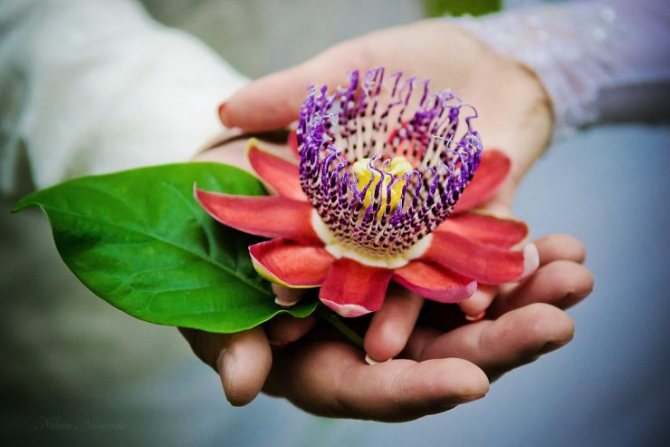

Common types:
Giant. Large leaves with d = 20 cm.
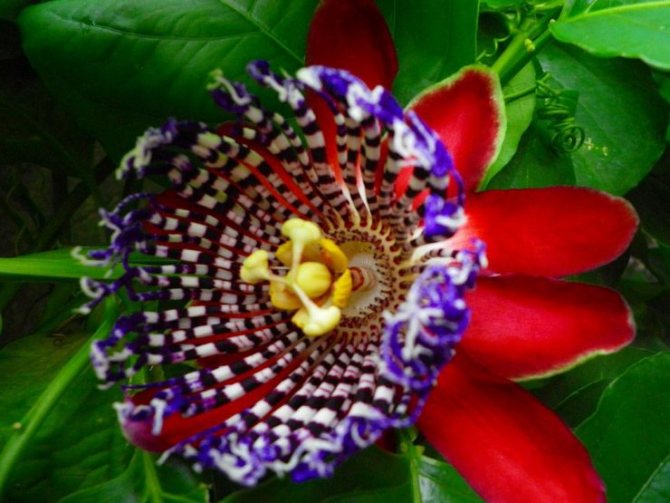

Incarnate. It has flowers painted in different shades of white, gray or purple. The plant is frost-resistant.
Banana. Passiflora flowers with d = 12 cm have a reddish tint. The edible fruit can be consumed. They are not eaten raw, they make delicious jam.
Winged. Orange flowers have long stamens. The large fruits give off a pleasant aroma.
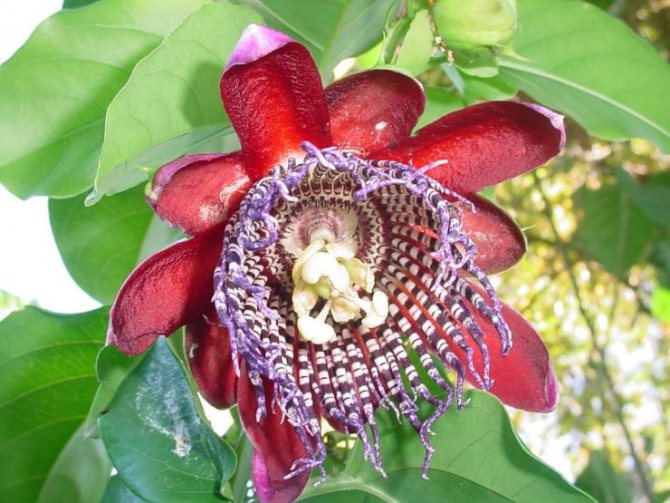

Blue. It is characterized by flowers of a lilac shade with a diameter of 10 cm. The plant bears fruit - orange berries.
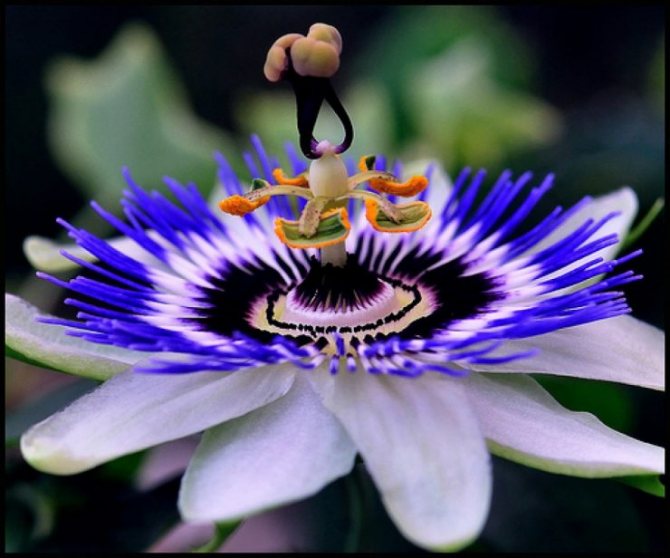

Laurel. The leaves resemble laurel, but their size is much larger.
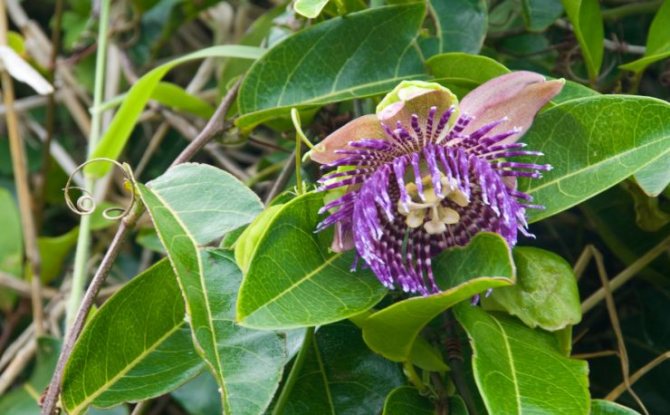

Who is contraindicated for passionflower preparations?
Contraindications for the use of passionflower preparations include intolerance to this plant, as well as pregnancy and lactation. They cannot be used for self-treatment of serious vascular diseases - hypertension, angina pectoris, impaired blood circulation in the brain. In such cases, a doctor's examination and drug therapy are required.
Passionflower and preparations from it belong to the group of agents that cope well with functional diseases. This means that disturbances in the functioning of the nervous system or heart are temporary, caused by overwork or stress. The plant is not used for treatment in children without the appointment of a pediatrician.
Description of the plant
The plant belongs to the family Stratus. It includes over 500 types. Many of them can be found in the tropical forests of South America, Australia, Polynesia, the tropics of the Mediterranean, Asia. Passionflower leaves are palm-lobed, whole. There can be from 5 to 9 pieces. The flowers have an unusual appearance. They have a "crown" of elongated fibers above the perianth.
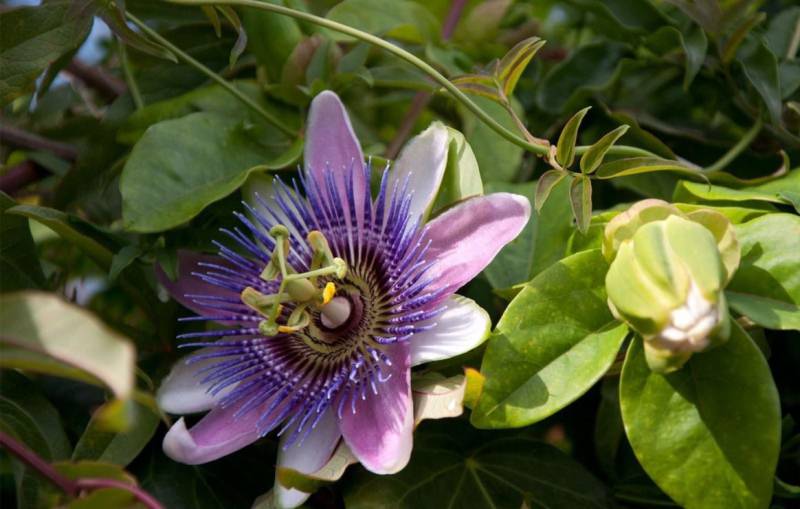

In the 17th century, the passionflower flower was compared to a symbol of Christ's suffering - a crown of thorns.
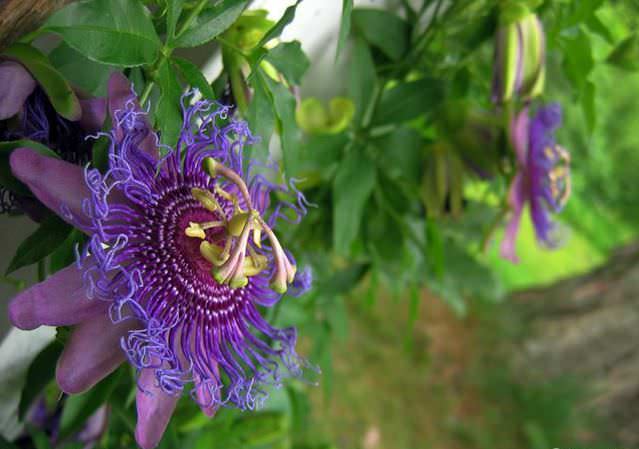

Use of passionflower in homeopathy
In homeopathy, passionflower is taken in the treatment of:
- alcoholism;
- opium addiction;
- convulsions in children;
- nervous tic;
- whooping cough, coughing fits, bronchial asthma;
- teething;
- helminthic invasions;
- exhaustion, general weakening in elderly and senile patients;
- spasms of any origin;
- neuroses;
- rheumatism, joint stiffness;
- bloating;
- overwork during physical or mental work;
- diarrhea with abdominal pain;
- erysipelas (lotions).
For therapy, it is necessary to make preparations according to individual prescriptions in a homeopathic pharmacy or receive ready-made drugs, but their dose is selected by a homeopath.
What does a passionflower (passionflower) houseplant look like?
Each species of the family Passifloraceae (Passiflora) in nature it has its own characteristics: it can be a shrub, one- or perennial herb with a strong stem. Flowers reach 10 cm in diameter, they have a characteristic bright color and star-shaped shape. Between the stamens and the perianth are rows of bright filaments that form the crown. Passionflower blooms from early July to October. At the same time, its individual varieties (for example, incarnata and blue passionflower) exude a delicate aroma that quickly disappears.
Passion flower leaves are dark green, large enough, whole or lobed. On them or on the petioles are peculiar "glands" that are imperceptible to the human eye.
They secrete a special liquid that attracts ants to them. These insects are necessary for the passion flower to protect against the main pests in the wild - the caterpillars of the Heliconia butterflies. The shape of the glands and their location can vary: some species have outgrowths that are visually similar to the eggs of butterflies. This makes the plant unattractive to insect pests, deceivingly demonstrating that it is already occupied by other heliconias.
Passion fruit tincture
To prepare the tincture, you need 500 g of passion fruit. The original recipe requires a bottle of rum, but it can be replaced with vodka as well. The pulp is removed from the fruit and rubbed with a glass of sugar. This mixture is mixed with alcohol and infused for a month. Then the mixture is filtered and taken in a tablespoon 2-3 times a day as a general tonic.
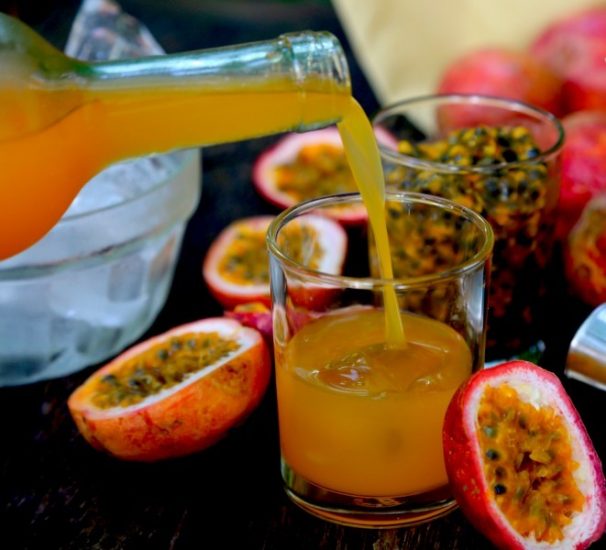

Passion fruit tincture
Pests.
Passionflower is rarely affected by pests. If this happens, most likely the florist makes mistakes in grooming. To rid a flower of a tick, a 2-fold treatment with an acaricidal agent (Fitoverm, Aktellik, etc.) is required at a weekly interval. The solution must be prepared in accordance with the manufacturer's instructions. Watering with a solution of a systemic agent (for example, Aktara) helps well against any other pests. Usually the 1st treatment is sufficient. In a too neglected case, you can repeat the watering after 2 weeks. Prepare the solution according to the manufacturer's recommendations.
Subscribe to our Telegram channel
Folk recipes with passionflower
Tincture, decoction and medicinal tea are prepared from the plant at home.
Vodka tincture
Cooking requires two tablespoons of young leaves (they are smaller in size). They are crushed fresh and filled with 200 ml of vodka. You need to insist in a dark place for 15 days. At one time, a teaspoon is diluted in 100 ml of warm water and taken 2 times a day (after lunch and dinner) for 20 days.
Decoction
A teaspoon of chopped leaves is poured into 150 ml of boiling water, kept in a water bath for 15 minutes. After straining, the broth is drunk warm with the addition of a coffee spoon of honey 40 minutes before bedtime. The course of treatment is 30 - 45 days. Recommended for hyperexcitability, fluctuations in blood pressure, nighttime hot flashes associated with menopause.
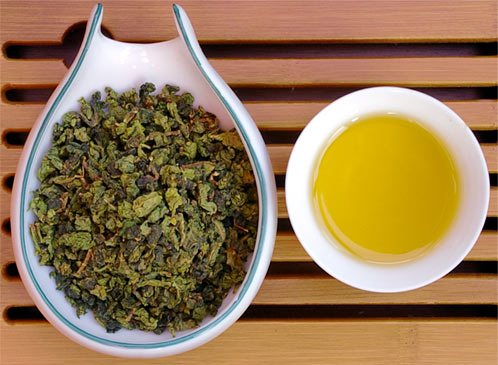

Honey and chopped passionflower leaves for decoction
Healing tea
One teaspoon of the herb is poured into half a glass of boiling water. You can also take mint and lemon balm in equal parts (each plant has a coffee spoon). Cover the glass with the infusion and leave for 10 minutes. Strain and drink before meals for stomach pain, premenstrual syndrome, headache and heartache, or half an hour before bedtime for insomnia.
Long-term use of passionflower tea (2 months) reduces the craving for alcohol.
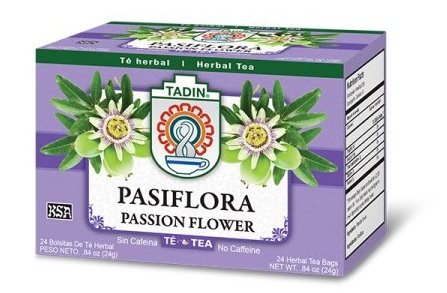

Popular types of passionflower
More than 400 species of passionflower grow in nature, but it is impossible to determine the exact amount. Because she lives in hard-to-reach places. However, there are some fruitful varieties that can be grown at home.
These species have good frost resistance and can be grown outdoors at temperatures down to -15 ° C.
These include:
- Incarnate (passiflora incarnata).
Plant up to 9 m long with a developed horizontal rhizome 3-15 mm thick. Stems are round and smooth without support. Leaves are leathery, simple, tripartite type with a wedge-shaped base and oblong-ovate sharp-serrate sides. They are dark green above, and light green below, 6-18 cm long and 8-20 cm wide. They are located at a distance of 4-12 mm from each other.
Flowers with a double perianth with a diameter of 70-90 mm. They are bisexual of the correct shape. Petals and sepals are broadly lanceolate, leathery, lavender with a green base, 3 cm long and 10 mm wide. In the center of the receptacle there are stamens and pistils, thick dorsally flattened. Fruits are oval, greenish-yellow, 5-7 cm long and 30-40 mm wide. The flowering period is June - September, and the fruiting period is August - October.
- Carulea (passiflora caerulea).
It has smooth, climbing on the support, stems 5-15 meters long. Fused at the base, the leaves are three-part. They have veins with noticeable ptosis and a well-developed petiole. The petioles and leaves secrete a fluid that attracts ants.
The star-shaped flowers are large, up to 90 mm in diameter, purple. Sepals and petals are light. Spur-like outgrowths are located on the lower part of the sepals. Between the perianth and stamens are bright tricolor threads that form a crown. The stamens are green-yellow, and the pistils are purple. Fruits are yellow or orange, up to 6 cm long and 40 mm wide. Blooms profusely from March to October.
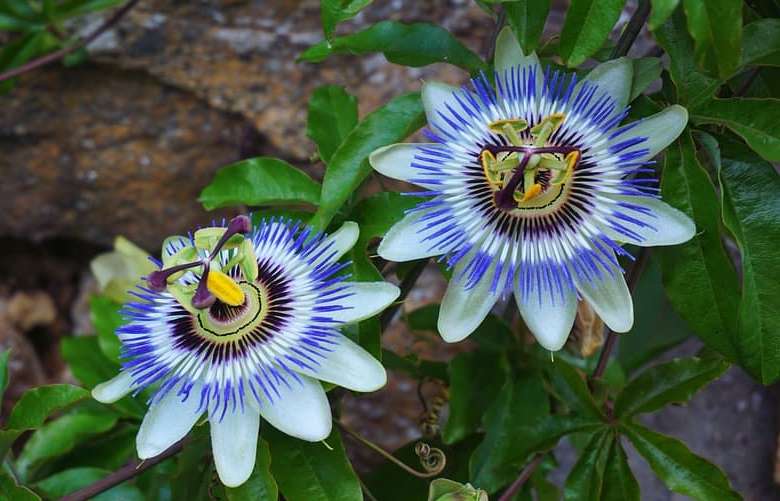

- Edible Maestro.
A low-growing plant, characterized by rapid growth, can reach up to 4.5 m in length. On long shoots, there are many antennae with the help of which passionflower clings to the support. The leaves are large, glossy, 3-lobe. Flowers of lilac-white color with a diameter of 80-120 mm. Egg-shaped fruits are red-brown or yellow-green in color. Fruits for the first time in the 2nd year after planting.
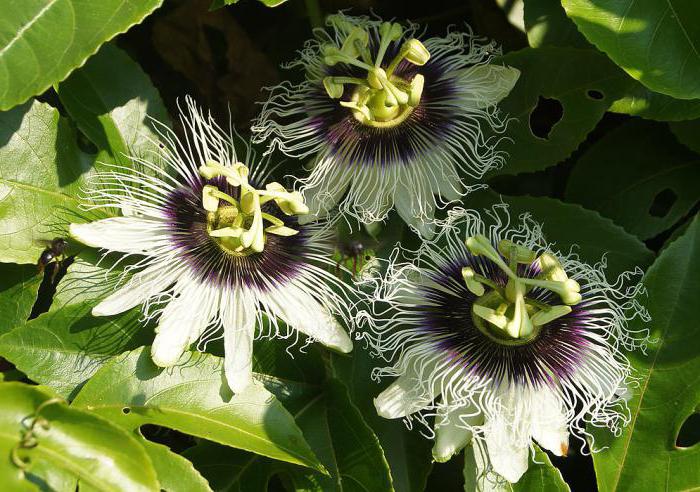

Contraindications
It is not recommended to take pills, capsules with plant extract, as well as prepare phytopreparations yourself if you have:
- hypersensitivity;
- allergic reactions;
- stomach ulcer;
- kidney or gallbladder stones;
- pregnancy, lactation;
- tendency to hypotension.
Passion flower can reduce the speed of psychomotor reactions, therefore, it is not recommended for transport drivers or operators of complex machinery in production. The hypnotic effect is enhanced by the simultaneous use of medications with a depressing effect on the brain (tranquilizers, barbiturates). During the period of treatment, alcohol is prohibited.
Particular care is needed when combining anxiety syndrome and such signs:
- chest pain radiating to the scapula, lower jaw, back, arm (especially with left-sided localization);
- frequent and irregular heartbeat, accompanied by shortness of breath;
- a sharp increase in blood pressure;
- nausea, vomiting, dizziness, weakness in the limbs;
- emaciation, feeling hot, dry mouth;
- the appearance of tremors in the hands, restlessness on an empty stomach or after physical exertion.
Such manifestations are an indication for an immediate visit to a doctor; the use of any means on their own can lead to serious consequences.
We recommend reading the article on dietary supplements for blood pressure. From it you will learn about the effectiveness of dietary supplements from pressure and their treatment to normalize high blood pressure. And here is more about how to reduce blood pressure without pills.
Passion flower-based preparations have a tranquilizing, antidepressant, antispasmodic and hypnotic effect. They are prescribed for neuroses, functional disorders of the cardiovascular and digestive systems, for the prevention of side effects of certain medications. For treatment, they use ready-made medications or decoctions, infusions and tinctures according to folk recipes.
Growing passionflower - the main rules
Temperature
Despite its tropical origin, passionflower feels depressed if the air temperature rises above 26 degrees. In the heat, the plant begins to turn yellow and lose leaves. Therefore, for abundant flowering and the normal state of the vines, you need to monitor the temperature regime, maintaining high humidity with the help of spraying.
Proper care will allow you to grow a real miracle on your personal plot
Sensual and passionate red passionflower with a blue center
Humidity
The high humidity of the air guarantees the excellent condition of the plants. Native to the damp tropics, passionflower requires frequent and regular spraying.
Watering
Watering is equally important - the soil must be constantly moistened, but care must be taken that the water does not stagnate. The easiest way is to ensure this with abundant watering, followed by draining excess water from the pan.
Lighting
As an airy inhabitant of hot regions, the vine needs bright lighting - it is not afraid of even the direct rays of the sun. To avoid problems, you need to accustom the plant to high solar radiation, and then it can be placed on the southern windows without additional darkening. It is only important to ensure that drops of water do not fall on the leaf blades on the sunniest days - they can work like lenses and harm the plant.
Passionflower never ceases to amaze with its beauty
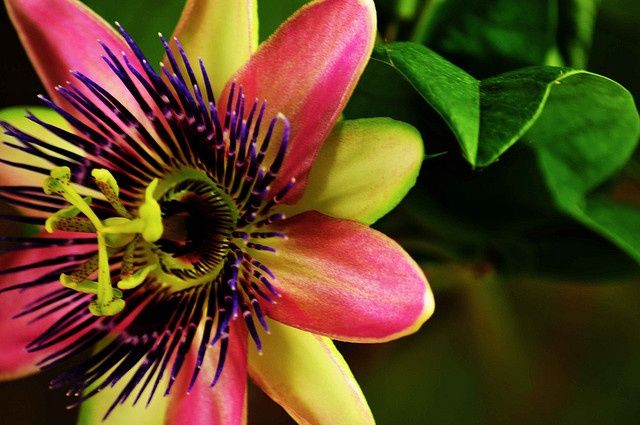

The flower of this species looks very tasty, reminding of juicy fruits.
Top dressing
Plant feeding is carried out twice a month, for which traditional complex fertilizers are used. If this condition is neglected, flowering will be scarce, no ovaries are formed, and the plant itself becomes depressed and loses its healthy appearance.
Pruning
When growing passionflower in the open field, it is necessary to carry out pruning in the fall - remove all shoots, and cover the rest with insulating material (foliage, straw, peat, etc.)
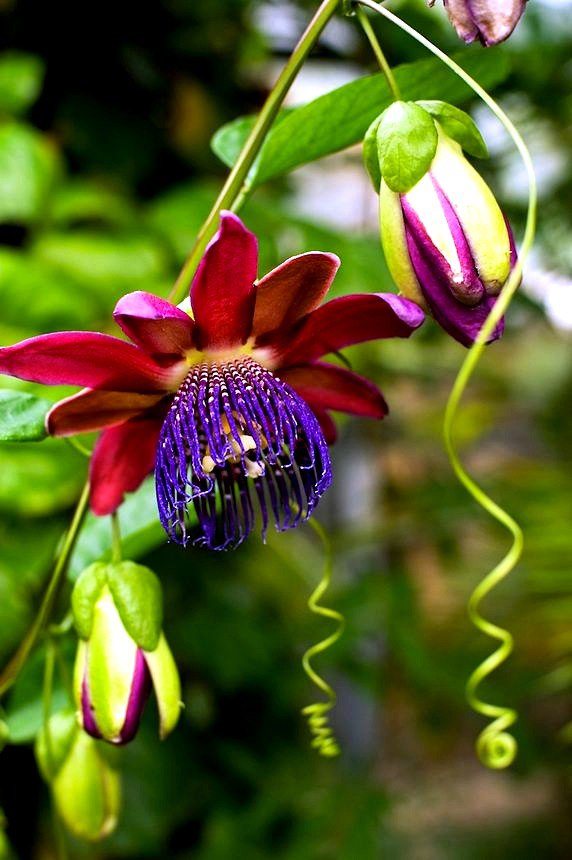

Passionate and sensual goddess in the world of flowers
The luxurious flower also attracts uninvited parasitic guests, so it is important to monitor and carefully care for the passionflower.
Diseases
Unfortunately, this decorative liana is quite often damaged by parasites - spider mites, aphids, mealybugs, scale insects.
Most viral diseases are incurable, so you will have to get rid of the plants completely.
The use of passion fruit for food
In our country, the fruits of edible passionflower (passionfruit and other species) can be found only in additions to yoghurts, ice cream or juice. It is very rare for a piece of fruit to be found in tropical tea blends.
The pulp of this fruit is very tasty and sweet, at home it is consumed both raw, mixed with sugar and water, and for making jams, jellies and sherbets. Pieces of this fruit are often added to curd desserts and cakes.
Sweet juice and jam can be used in preparing meat and fish dishes, the fruit is best combined with nuts, apples, cinnamon and pears.
However, care should be taken, since some varieties (for example, Azure Passionflower) contain a small percentage of cyanide, while some others contain weaker toxic substances that are harmful to human health.
How many times does passionflower need to be watered?
The flower needs a well-moistened soil.
- In the summer, water should be watered several times a week.
- The soil should always be moist.
- In autumn and winter, watering should be reduced.
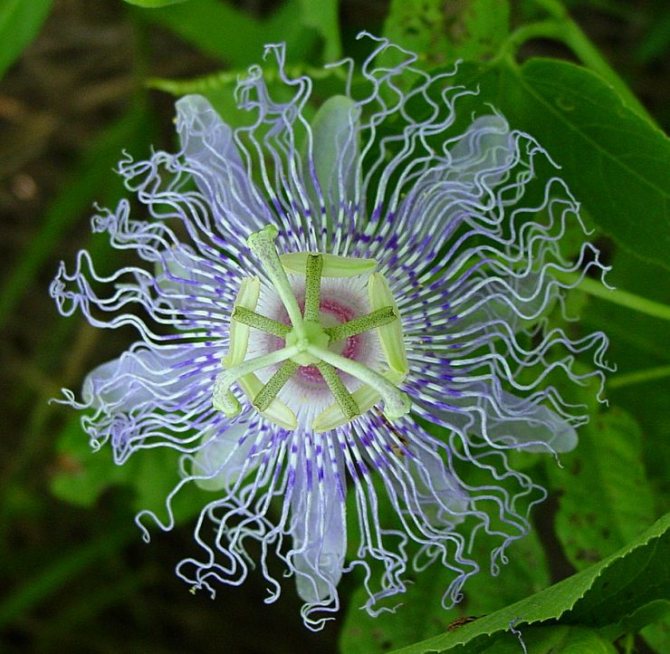

In the evening, the flower is sprayed with water. If you want to shower, it is important to be careful not to damage the stems.
Why problems arise and how to solve them
Passionflower is a powerful vine, very tenacious and resistant to various lesions. But with regular violation of the rules of its content, unpleasant consequences cannot be avoided.
Table: yellowing leaves, buds and flowers breaking off, and other consequences of care errors
| Signs | Possible reasons | Elimination |
| The tips of the leaves are dry and brown |
|
|
| The leaves are lethargic, twisted | Low room temperature | Raise the temperature |
| Leaves fall and turn yellow | Low temperature and insufficient air humidity | Increase temperature and humidity |
|
|
|
| Stalk rots | Excess moisture |
|
| Buds or flowers break off and fall off |
|
|
Pests of indoor plants can also settle on passionflower.
Table: pests of passionflower
| Pest | Signs of defeat | Control measures | Prophylaxis |
| Spider mite | A cobweb appears on the lower surface of the leaf and small black dots - ticks are visible. |
|
|
| Aphid |
| ||
| Mealybug | A sticky coating similar to cotton wool appears on the leaves and shoots. | Insecticide Aktara (4 g per 5 l of water): carry out 4 sprays and 4 spills with this soil solution in a pot at intervals of 7-8 days. | |
| Shield | Plaque and small brown bumps appear on shoots and leaves. | ||
| Thrips | The leaves are covered with white larval tunnels. |
Passion flower - reproduction
Growing passionflower from seeds
If you have harvested seeds from your own passion flower, keep in mind that freshly harvested seeds have about 30% germination, while last year's only 1-2%, so it is better to buy seeds from a reliable supplier and sow them in late winter or early spring. Before sowing passionflower seeds, they are scarified - they damage the hard shell with a fine skin. After that, the seeds should be soaked in warm water (25 ºC) for two days, and after this period, the seeds that remained floating on the surface should be discarded - they are not viable. Swollen seeds are spread over the surface of the soil and slightly pressed into it.
To create one hundred percent moisture required for germination of seeds, the container with the inoculation is covered with glass or transparent airtight film, placed under bright diffused light and kept at a temperature of 20-25 ºC.When the sprouts appear, remove the glass or film and provide the sprouts with twelve hours of daylight hours with the help of additional lighting. When the seedlings have the first pair of true leaves, they are carefully dived, trying to keep an earthen lump on the roots and not burying the seedlings too much in the ground.
Growing passionflower is a long process: you will have to wait for seedlings from a month to a year, and passionflower from seeds will bloom only after eight years.
- Azalea transplant
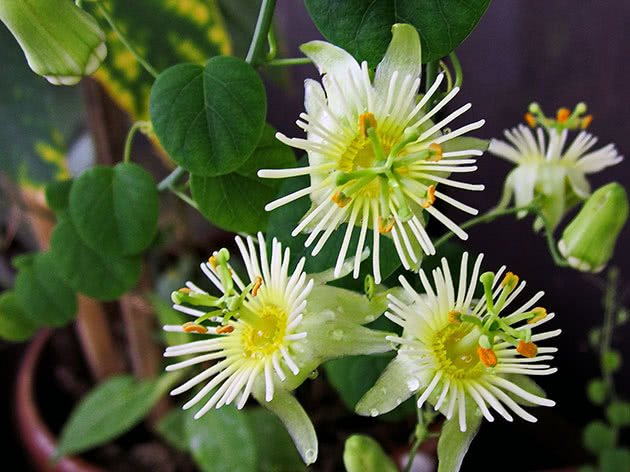

Passiflora cuttings
Passionflower propagates by cuttings, which are cut from new spring shoots. Passion flower cuttings must have at least two pairs of leaves and a growing point. The lower pair of leaves is removed during grafting, the lower cut is processed with a root former.
In a pot with a drainage layer, soil is placed from sod land in half with chernozem, deep holes are made in the soil with a pencil to the very bottom, cuttings are inserted into these holes so that the pair of leaves remaining on the cutting is flush with the surface, then the soil is moistened, and above the cuttings building a greenhouse using an arched structure and a transparent plastic bag. The package must be removed for five minutes daily to ventilate the cuttings, the soil must not dry out, the temperature for successful rooting of cuttings is maintained within 21 ºC.
After three weeks, the cover from the cuttings can be removed, and when they get stronger and grow up, they are transplanted into the soil for passionflower. You can also root cuttings in water: a cutting is placed in a jar of water and a piece of charcoal and, without changing the water, they wait until the roots grow back - it takes one and a half to two months.
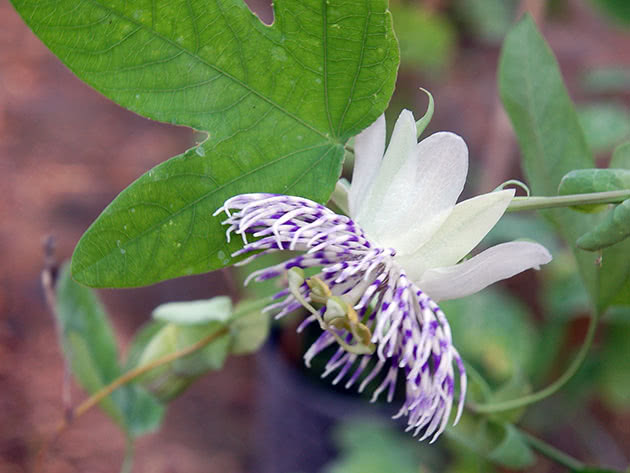

General description, photo of flowers
Passionflower is a member of the Passionflower family, which is why it got its second name. It can be a herbaceous, but more often a liano-shrub evergreen perennial. The life cycle can also be different - one-year or long-term. Lignified shoots of shrub forms have a sympodial structure, i.e. branch not from the central shoot, but successively lengthening due to lateral stems. The structure of the leaves is simple, they can be whole or lobular, painted in a rich green color.
Flowers are formed on long stalks. Their shape is amazing and diverse, the color is very bright, tropically variegated, the average size in diameter is about 10 cm. The petals are similar in appearance to sepals, in total there are 10 of them. In the center of the bud there is an ovary with 3 stigmas. Anthers and stamens are also very decorative, large and well visible.
Most varieties of passionflower bloom very aromatic, but not for long, the life of the inflorescences is short, up to 1 day, which is redeemed by their amazing brightness and intricacy of forms. Flowering usually falls in the second half of summer or early autumn. The fruit of passionflower in many varieties is edible, its size depends on the species, it resembles a large pear or egg in shape. This flower grows quickly, it is used as a home vine or as an ampelous culture.
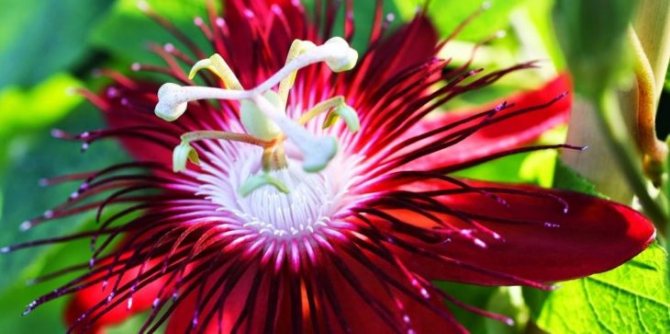

How passionflower is grown from seeds
To grow a flower of passion in our apartment, we go to the store and buy passionflower seeds. When buying, you need to carefully study the release date, which is spelled out on the package. If the seeds are old, they will germinate within a year. But even freshly harvested seeds will not give quick shoots.
The type of passionflower directly depends on how long it takes for passionflower seeds to germinate. In one species, this process will take a couple of weeks, while other seedlings may appear in 3-5 months, and sometimes even one year.
The recommendations prescribe mandatory stratification, since it is difficult to maintain the necessary conditions for seed germination for several months.Before planting, 24 hours before, you need to soak the stratified seeds in lemon or orange juice, which is squeezed out on a juicer.
Passionflower seeds, which hatch normally, can simply be processed in Kornevin. To maximize plant shoots, seeds are sown in peat tablets. You can also plant them in light soil: coarse sand, humus soil, deciduous compost and peat. Take all the components in one piece.
A soil mixture that has been prepared by yourself is recommended to be treated with a high temperature. For this, oven roasting is quite suitable. Pour the soil onto a baking sheet and place in a preheated oven for 15-20 minutes.
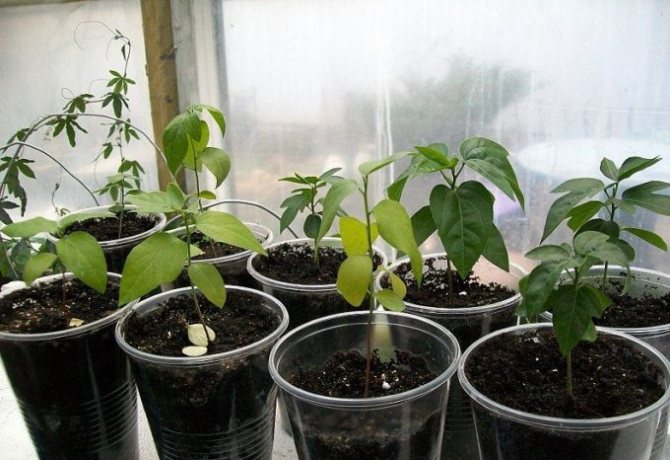

Planting seeds
Seeds are sown in peat containers in February. Planting depth within 1-2 centimeters. After sowing, the container must be covered with plastic wrap from above and placed on a warm battery for maturation, so that heating is done from below.
Open and ventilate the film every day. Spray the soil with water as needed. After the green shoots appear, the container is placed in a place with good lighting. Passionflower seeds can be germinated even before they are sown in the potting mix. The algorithm of actions is as follows:
- It is recommended to soak the seeds of the flower of passion in distilled water for a day. That is, the grains that have floated to the surface are removed;
- Selected seeds for disinfection and better germination can be soaked in a solution liquid consisting of water and 3% hydrogen peroxide. The ratio is as follows: peroxide - 50 drops, water - 100 ml.;
- The seeds are placed in a glass container, poured with a solution, then removed for 1-2 weeks in a dark place. Until the shoots appear, the lid is opened briefly for airing;
- As soon as the seeds germinate, they must be carefully separated with tweezers and transplanted into prepared peat tablets;
- Seed material that remains can also be filled with mortar and left until germination.
Popular: The growing seasons of plants from germination to maturation
Another way to grow vines
There is another way that helps to significantly reduce the germination period of passionflower seeds. This technique is applied using a temperature difference. Let's take a quick look at it:
- Sow seeds in prepared containers, which are covered with plastic wrap on top;
- The containers are placed in a place that is well lit by sunlight;
- In the process of seed germination, it is necessary that there is a significant temperature difference. For example, in the daytime the air should warm up to + 28-30C, at night - up to + 10-12C. Usually this temperature is at night on the balcony;
- As the first green shoots appear, the film is removed. Usually, up to this point, on average, it takes up to two months.
It does not matter in what way the passionflower seeds are sown, the pick is made at the moment of the appearance of two full-fledged leaves. For transplanting plants, prepare containers with a diameter of up to 7 centimeters. A small drainage layer is placed in each pot. Usually this is ¼ of the total.
Passion flower seedling care
The sprout pots should be placed on the west or east window, which is well lit during the daytime. Water the plants frequently, but little by little, so that the root system does not rot.
In the summertime, maintain the temperature within + 24-25C, and in the winter - up to + 12-13C. In a hot summer, the deciduous part of the plant must be refreshed with water from a spray bottle. Also at this time, the "cavalry star" is fed a couple of times.
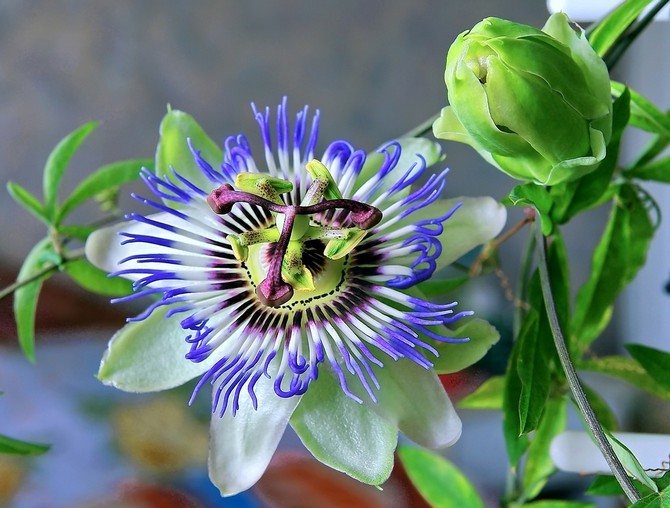

For the formation of the skeleton during the first year, it is required to attach the main branch of the flower to the support. If this is not done, then subsequently the central branch will stop growing, and instead, lateral shoots will actively develop.The rest of the branches in passionflower are pruned and crown formed. Moreover, these procedures are carried out every year. This is a very important point, since the plant throws flower stalks only on young one-year branches.
The most common types and varieties of passion flower
Some types of passion fruit can be grown at home. Read more in this article.
Sweet granadilla
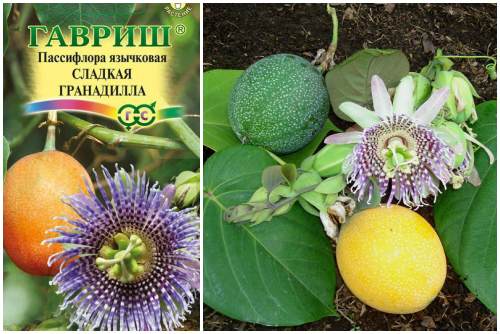

Other names - "Passionflower reed" or "Passionflower reed". Shoots are capable of growing up to 3-4 meters during the summer season.
It is used for fruit production as well as vertical gardening. Cultivated on tropical islands: Hawaii, Haiti, Jamaica. Natural habitat - Mexico, Bolivia.
Passionflower blue
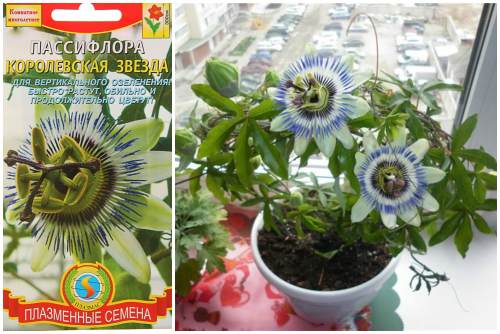

Her homeland is Brazil. The color of the petals ranges from gray to cyan or magenta. The most common variety is the Royal Star (Cavalier Star).
Blue Cassiopeia
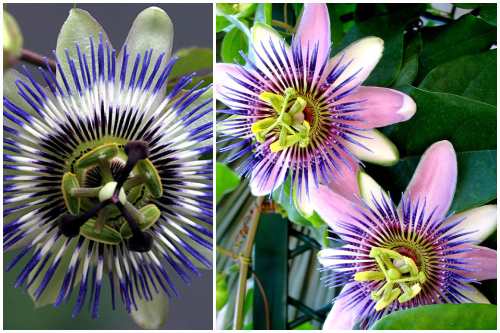

One of the varieties of blue passionflower.
Giant granadilla
The liana is striking in its size - it stretches up to 45 meters in length, twisting around the support. The berry is also gigantic, compared to other types of passionfruit: 10 - 30 cm. Due to its size, it got its name. Lives in South America, Malaysia, Africa, Australia.
Passionflower volatile
It has small, very decorative flowers. This beautiful plant has another name - "Stinky Passion Flower". Such, rather not euphonious name, he received because of the unpleasant smell that stands out if you rub his leaves between your fingers.
Passionflower meat - red
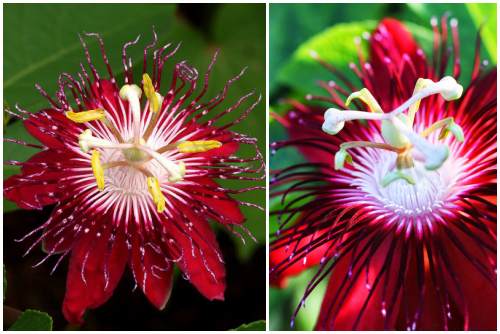

This species is very moody. The stems are covered with fine hairs that resemble a downy; the leaves are oval, with a jagged edge. The flowers are very bright, crimson red.
Photo of passionflower
Breeding methods for passfilora
Passion flower is propagated by two methods: seeds and vegetatively.
Cutting is best done in the spring.
- Prepare containers with drainage and substrate based on peat, pine needles and sand.
- Separate the shoots with 2-3 healthy leaves with disinfected scissors.
- Treat the cuts with charcoal chips or cinnamon.
- Place the cuttings in individual prepared containers.
- Create greenhouse conditions: cover with a bag or film, ventilate, place on the sunny side, maintain a comfortable temperature and humidity.
- Once the sprouts form a strong root system, they need to be transplanted into standard pots.
By sowing, propagation is much more difficult. This method is good for summer.
- First you need to damage the outer shell of the seed by rubbing it on fine sandpaper.
- Place in water for a day.
- Prepare a nutritious soil with peat and spread the seeds on the surface of a common container.
- Press down, but do not bury them more than 0.5 cm into the substrate.
- Create greenhouse conditions: cover with a bag or film, ventilate, place on the sunny side, maintain a comfortable temperature (+ 22 ° C) and humidity.
- After a rather long period (up to 1 year), the first shoots will appear, then the coating must be removed and the passion flower transplanted into an individual container.
Fertilizers for Passiflora
Feed the flower with organic fertilizers or mineral complexes. Dilute the top dressing with water and water.
This should be done in the spring and summer three times a month. Every month and a half from April to September, make a foliar dressing consisting of microelements.
Advice! An alternation of organic and mineral fertilizers will be beneficial for the plant.
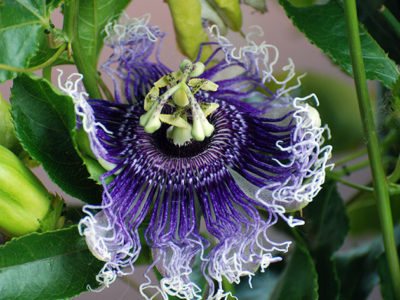

Cosmetics containing passionflower
The ingredients in passionflower-based cosmetics can now be useful in many skin care products, both in cosmetic and dermatological lines.
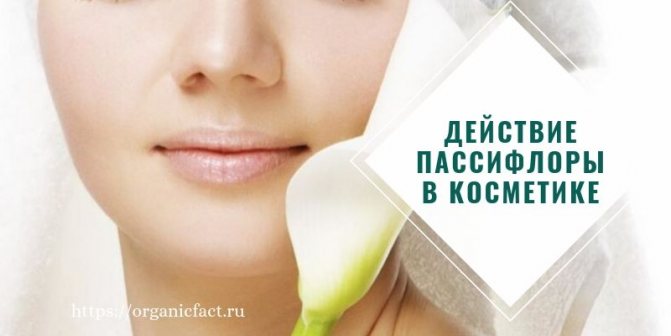

However, in general, cosmetics based on passionflower are intended for the care of the skin of the face and the area around the eyes, since these are quite expensive raw materials.
Passion flower soil
The land for growing Passiflora should be soft, fertile and well ventilated. The stores sell ready-made soil options, for example, for lemon or begonias.
If you are making the soil yourself, you need to mix in equal proportions deciduous or sod soil with peat and sand.
Advice! Make a drainage layer (2-3 cm) of rubble, small pebbles or expanded clay at the bottom of the pot. This drainage will drain excess moisture from the soil, protecting the plant from dampness.
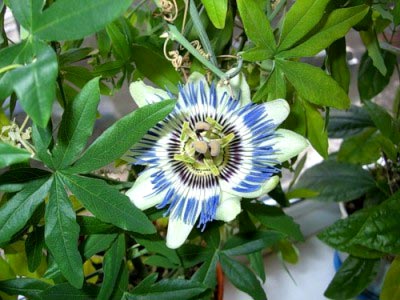

How to transplant passionflower correctly?
The young plant is transplanted every year. For adults, the frequency of this procedure is once every three years. Each time you need to take a new container with a diameter larger than the old one.
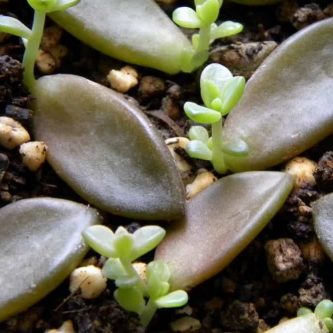

How to properly care for a money tree: transplantation, reproduction, circumcision, disease. 30+ photos, signs- Echeveria - how to care for indoor succulent plants? Watering and soil selection features (55 photos + video)
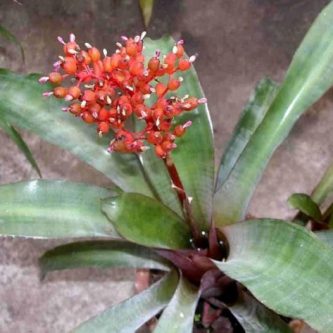

Ehmeya: indoor ornamental flowering plant. Nursing feeding and reproduction (54 photos)
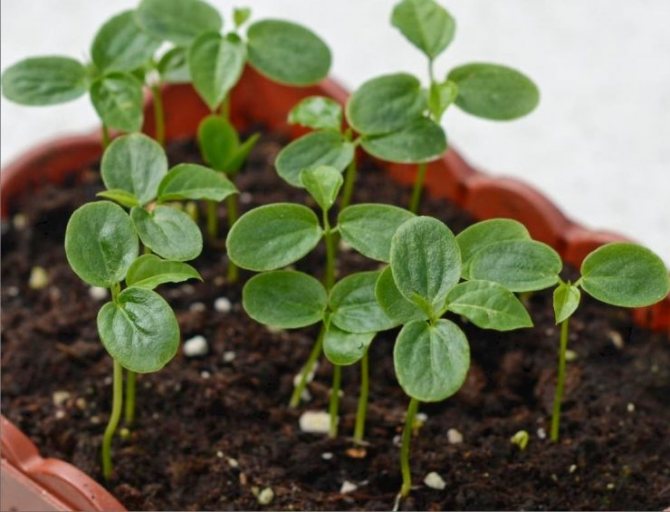

When transplanting, it is important to remove all rotten roots. To prevent the spread of infection, pruning is done with a knife treated with a disinfectant solution.
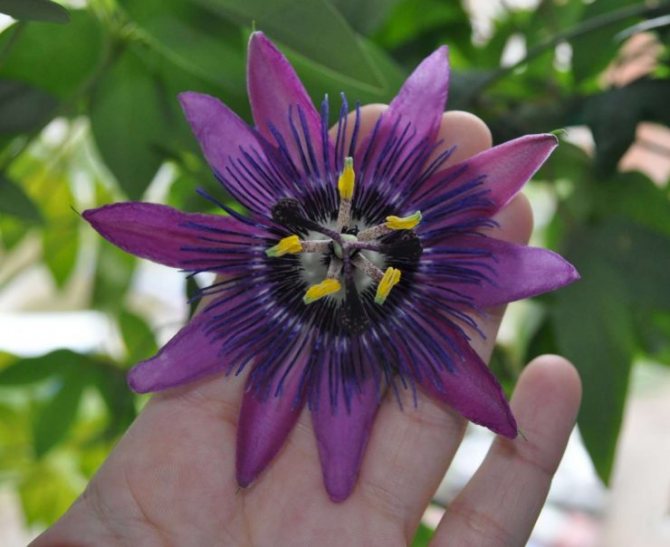

It is necessary to capture a healthy root system by about 2 cm. After that, the sections are treated with potassium permanganate. Don't forget to update your drainage.
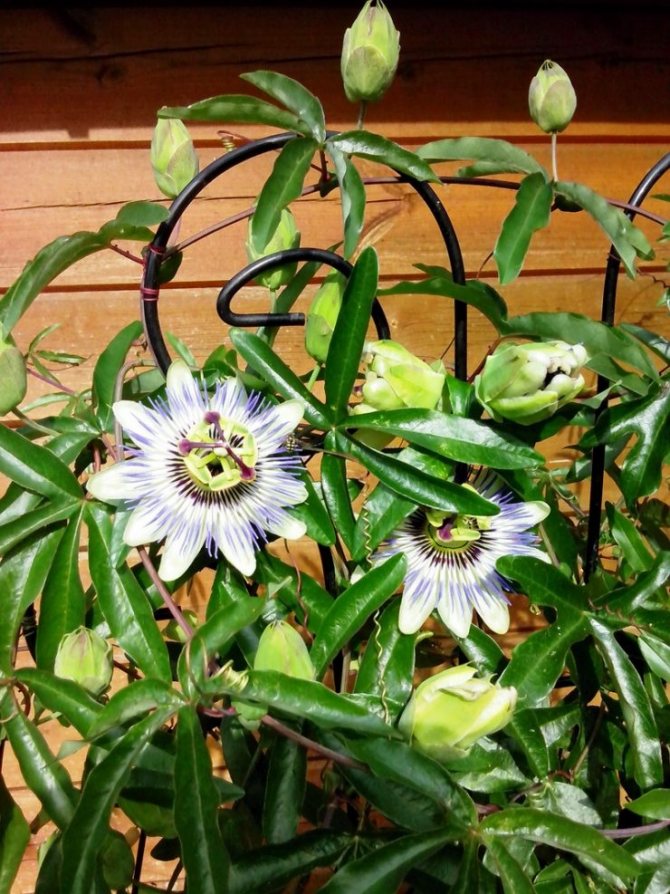

Description
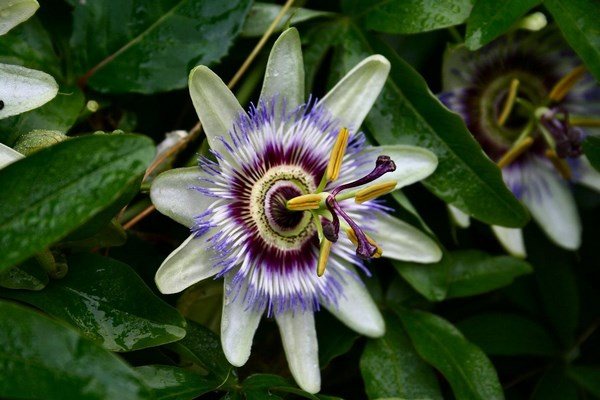

Passionflower, which is also called the "cavalier star", comes from the Passionflower family. In nature, it is distributed in the tropical and subtropical forests of Australia, America and Asia. More than 400 species belong to the genus Passiflora.
An evergreen herbaceous or bushy vine has long stems. They cling to supports and rise to great heights. Most passion flowers are perennial crops, but there are several dozen species of annuals. As the bush develops, the stems become hard, lignified. The shape of the leaf plates is oval or ovoid with a pointed apex. In some species, the leaves are divided into three lobes and resemble bird prints in their appearance. The length of the leaf plates reaches 25 cm. In most species, they are colored dark green. Sometimes there are varieties with lighter shades or multi-colored colors.
The flower is the main decoration of passionflower. During the flowering period, they cover the stems abundantly. Buds are formed in the leaf axils one at a time, less often two. Their size ranges from 4 to 15 cm in diameter, but in most species the diameter of the flowers reaches 10 cm. In shape, they resemble a star with five petals and the same number of sepals. Inside is a pistil with three stigmas and 5 stamens. They are surrounded by numerous bracts.
Liana has a high growth rate. In nature, there are species that can bloom in the first year after planting. But most bloom later. Plants obtained by vegetative propagation form the first flowers in 2-3 years. When grown by seed, flowering begins only after 5 years.
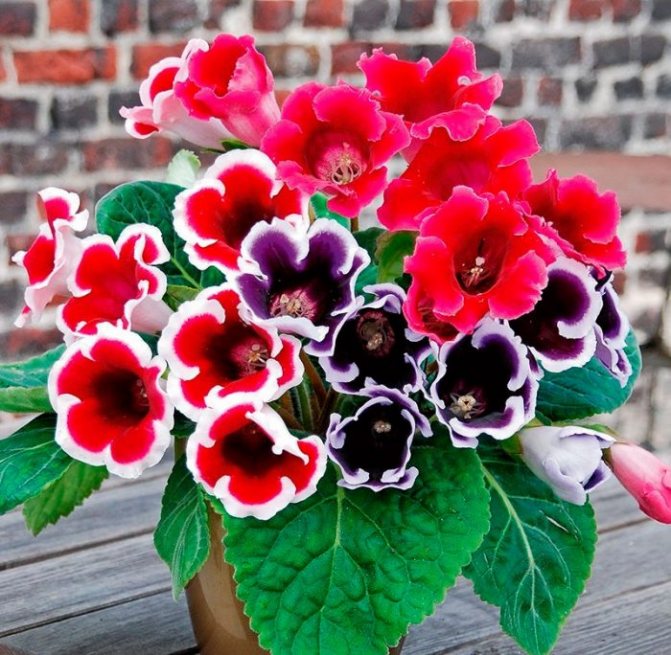

Passionflower in winter
Most species of this plant are afraid of frost. In winter, temperatures below +12 degrees Celsius are fatal to the flower. Therefore, try to keep the plant in a warm room and then it will not die.
Also, keep the soil dry and maintain good light levels.
Advice! Keep Passionflower away from areas subject to sudden changes in temperature and drafts. She can lose all foliage and buds.
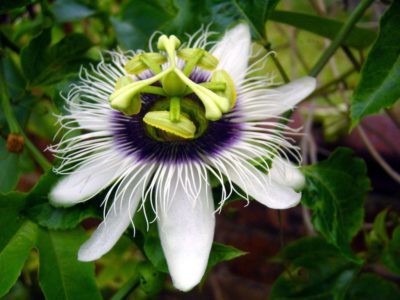

Pot size for Passiflora
At the very beginning of growth, the flower needs an ordinary plastic container with a diameter of no more than 10 cm.As Passiflora develops, it is necessary to select larger pots for it.
Try to choose such a container so that there is a margin of soil volume. Both plastic and ceramic pots are suitable for transplanting.
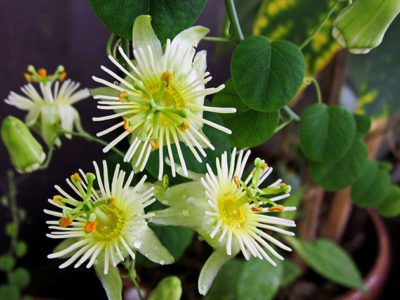

How to plant passionflower with cuttings?
A feature of this method is the rooting of cuttings not in the ground, but in water with the addition of charcoal suspension. Having placed the cuttings in the water, it should no longer be changed until the nascent new roots are visible. On average, it will take about 2 months, during which time the charcoal will protect the water from deterioration. After the formation of roots, the cuttings are transplanted into the ground and, for the first time, are covered with a film like a home greenhouse. This is necessary for adaptation and fast rooting.
Pruning the stems
After the plant has taken root normally, after 3 years, periodically once a year, the stems of passionflower must be pruned. This promotes the growth of new branches and the growth of the plant itself.
In the spring, a third of last year's branches are pruned, since flowering affects already new young shoots. In the summer, on the basis of homemade passionflower, excess growth grows, you need to get rid of it in the same way. After the flowering period, extra secondary stems will remain on the passionflower, shorten them by 3/4 of their length.
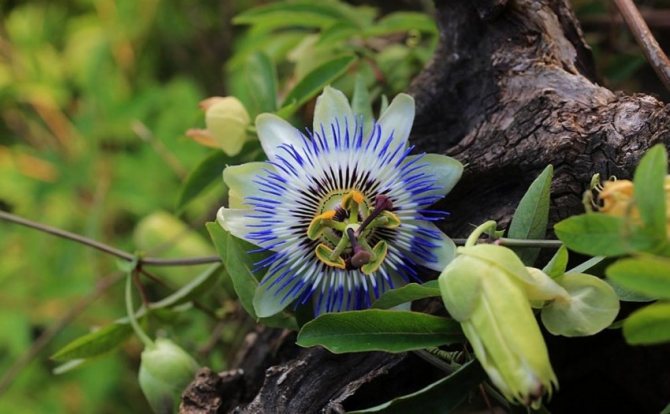

Propagation of passionflower by cuttings
Edible passionflower can be propagated in several ways, the easiest of which is by cuttings. Apical cuttings with buds are cut in summer to a length of up to 10 cm, and then rooted in the soil in a warm room (+ 20 ... + 25 ˚С). To prepare the soil mixture during planting, take 3 parts of leafy earth, 2 - humus, 2 - turf, 1 - sand.
Immediately before planting, they are treated with a root, then the pot with cuttings is covered with a film, within 1 month the cuttings take root. You can put the cuttings in water by adding a piece of charcoal for 1.5-2 months. roots should appear, but the water cannot be changed.
During the growing season, whisker breeding can also be done.
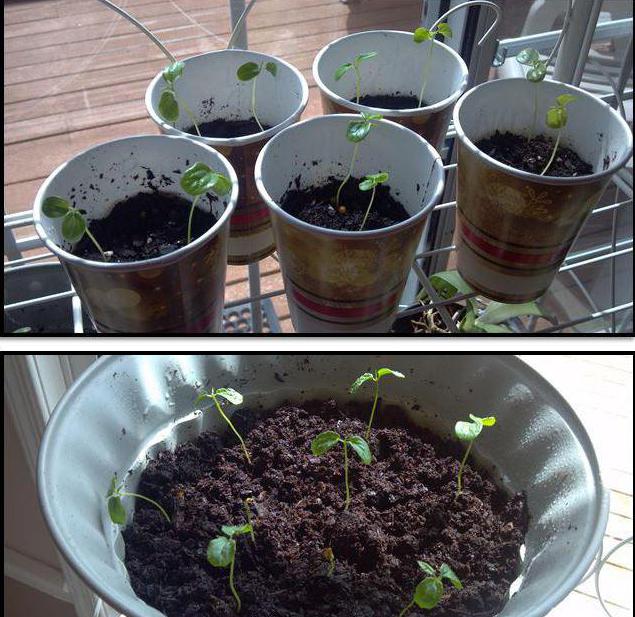

The action of passionflower in cosmetics
Passionflower oil, obtained from the seeds of the fruit of this plant, has a unique nutritional value that makes it very different from other vegetable oils.
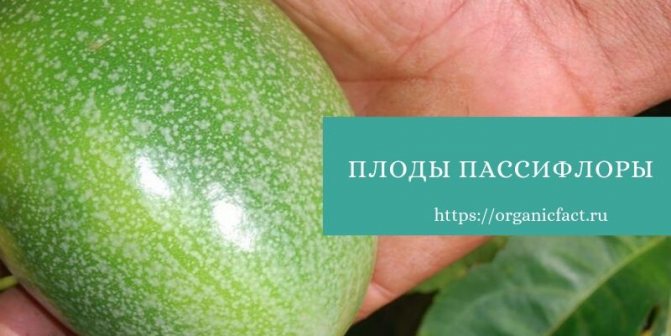

The proportions of cold-pressed oil fatty acids are distributed towards the high content of linoleic acid (72.6%), which belongs to omega-6.
Undoubtedly, it is one of the richest sources of linoleic acid used for the production of cosmetics. Passionflower extracts and oil are said to be powerful antioxidants because they besides healthy fats.
Passionflower also contains lycopene, carotenoids and phenolic compounds - these are very beneficial for the skin, especially when it comes to protecting it from UV damage. Passion flower's antioxidant action helps protect skin from damage from environmental pollutants.
As part of cosmetics, passionflower can exhibit several therapeutic properties: it is considered an excellent moisturizer for the skin and has an emollient effect. Used as an anti-inflammatory agent - passionflower oil and extracts of various parts of the plant reduce inflammation and irritation on the skin of any nature.
The antipruritic effect of this plant is appreciated: passionflower helps in the fight against the manifestations of allergies, relieving itching on the skin.
According to a number of studies, passionflower can reduce the synthesis of melanin (skin pigment), which makes it a useful ingredient in brightening cosmetics. It has also been found that passion flower extract helps stimulate the production of fibroblasts, the cells from which collagen is synthesized.

